
The Heart of Dixie
To call an area the heart of something is to say that it is a hub in the traditional sense—a place where important materials are concentrated and a center through which people pass on their way to somewhere else. But the phrase also implies an emotional pull, and the heart of Dixie is the bull’s-eye of the collective Southern soul.
In this Georgia-Alabama-Mississippi constellation, the largest star, shining big and bright, is Atlanta, Georgia. The distinguished journalist and former New York Times editor R.W. “Johnny” Apple, Jr., once described Atlanta as “a Deep South version of Los Angeles.” He may have been referring to both cities’ legendary traffic problems, but what he likely meant was that swirling around Atlanta’s historic core is a constant state of reinvention and evolution. The city’s roots aren’t as deep as those of some other Southern towns.
Originally called Terminus because it was the southeastern end of the Western & Atlantic Railroad line, Atlanta served as a link between Southern seaports and Chattanooga, Tennessee, and thus to the cities of the North.
What sprang up from the red Georgia clay to serve the railroad business quickly emerged and has forever after thrived as a city of commerce: Atlanta is home to corporate headquarters for Coca-Cola, Home Depot, and Delta Air Lines. Its airport is routinely ranked the busiest in the world, as measured by the number of passengers that parade through it each day. (Hence the old Southern adage: To get to heaven, you have to change planes in Atlanta first.)
Perhaps the most important thing to happen to Atlanta occurred in 1864 when Union General William Tecumseh Sherman and his forces burned the city. The carnage marked the beginning of the end of the Civil War (Sherman concluded his “March to the Sea” a month later in Savannah), and it set the tone for Atlanta’s character ever afterward. Visionary Atlantans rebuilt their city on the back of an idea called the “New South.” This meant a city willing to do business with anybody willing to do business in it, further contributing to Atlanta’s commerce-centric present.
Of course, Atlanta’s image as a New South city also was built in part by the Reverend Dr. Martin Luther King, Jr. He was born and is now buried on Auburn Avenue, where both he and his father preached at Ebenezer Baptist Church. King won the Nobel Peace Prize in 1964 when he was 35, the youngest person to do so at the time. (Another Georgian, former President Jimmy Carter, a native of Plains, Georgia, and a current Atlantan who works tirelessly for Habitat for Humanity, won the prize in 2002.) In the annals of colorful Atlantans one must also mention Ted Turner, the entrepreneur who began his career selling billboards and later almost single-handedly created what we now consider cable television.
There are 32 streets with “Peachtree” in their titles within the Atlanta metropolitan area. And on those 32 streets, what do the people find to eat? Atlantans have money to spend and sophisticated palates to tend. The city has produced one winner of the television reality cooking program Top Chef, the faux-hawked Richard Blais, he of the liquid nitrogen canisters and Krispy Kreme doughnut milk shakes. It also has helped produce the “winningest man in barbecue,” the outspoken Myron Mixon, from the town of Unadilla just two hours south. Together, Blais and Mixon represent the Atlanta food scene.
Do Atlantans like to eat barbecue and fried chicken and grits? You bet. Do they like pomegranate martinis and smoked salmon pizza? Yes, sir. And if they can get all of those dishes at the same place? They’re all for it. Atlanta diners are democratic; they are not encumbered by notions of what things are “supposed” to taste like—a virtue, perhaps, of existing in a relatively new town.
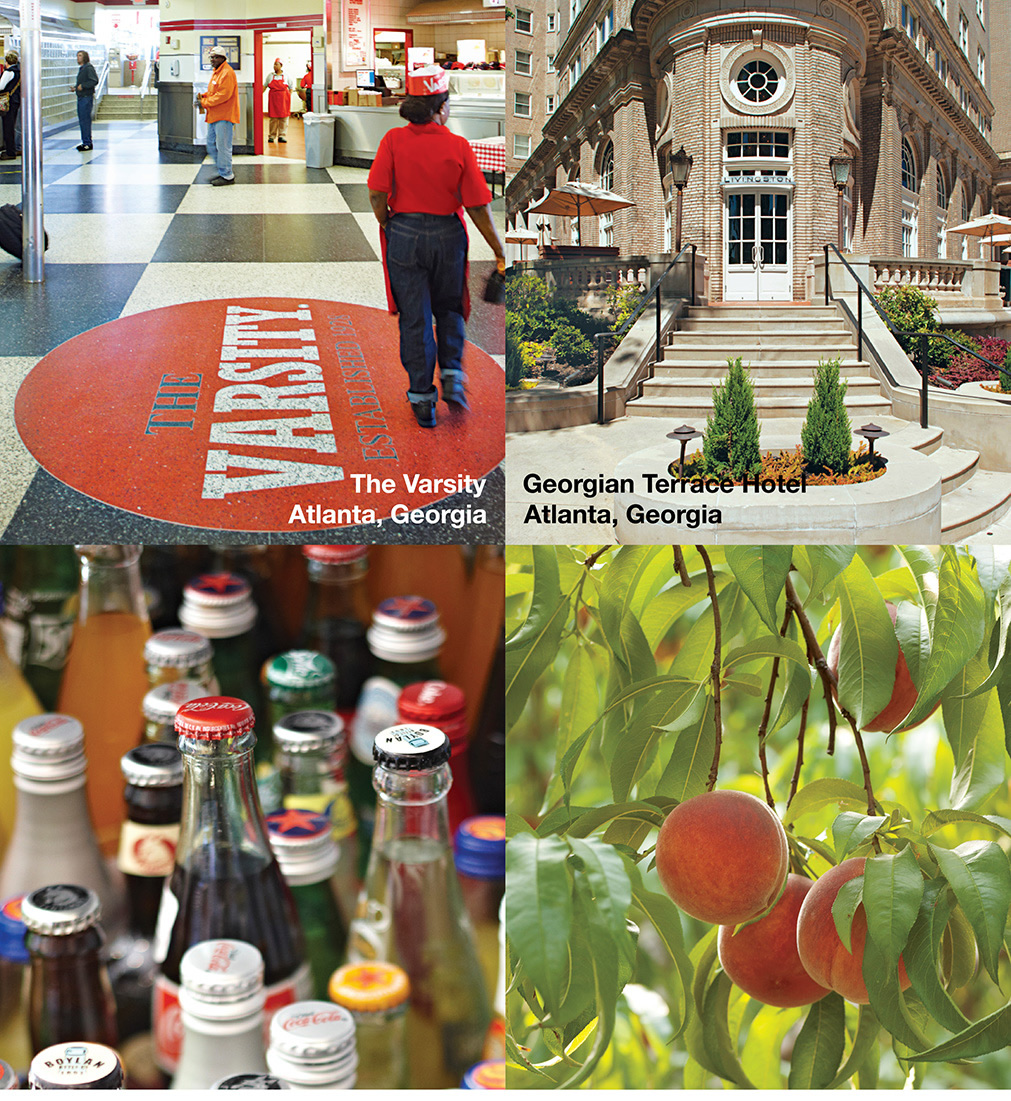
Atlanta diners are democratic. They like barbecue and chili dogs as well as pomegranate martinis and milk shakes made with liquid nitrogen.
About 150 miles west sits another big-time, big-name Southern city: Birmingham, Alabama. Like Atlanta, Birmingham owes its existence to railroads. The city was incorporated in 1871—after the Civil War and during Reconstruction—where the old South & North Railroad met up with the Alabama & Chattanooga Railroad. This was a strategic spot, indeed: The Alabama soil is laced with natural deposits of coal, iron ore, and limestone—the essentials of making steel and iron.
In those days and in that place, labor was cheap, and the steel and iron flowed. The city’s founders named the spot Birmingham after the United Kingdom’s industrial capital, and Alabama’s Birmingham so quickly became a foundation of industry that it acquired the nickname “Magic City”—because it seemingly grew up out of nothing overnight. (Another nickname, “The Pittsburgh of the South,” suggests steel but is less romantic.)
For most of its first 100 years Birmingham was a steel town, a boomtown, and presiding over it since 1906 has been a massive 56-foot cast-iron statue of Vulcan, the Roman god of fire and molten arts (including blacksmithing). Considered the planet’s largest cast-iron statue, Vulcan was commissioned by the city’s Commerce Club and sent to the historic 1904 World’s Fair in St. Louis to represent Birmingham. He still stands tall atop Red Mountain overlooking the downtown skyline, a living testament to industry (and to a time before gods wore pants).
Iron and steel carried Birmingham until the 1970s, when the industry began to decline—but there were some other problems before that. The Great Depression took a significant toll on the city’s economy and morale, laying the groundwork, some historians believe, for the massive Civil Rights unrest that took place there in the 1950s and 1960s. It’s been an uphill battle for Birmingham to overcome its image as a place where the U.S. government had to force the integration of schools and the Ku Klux Klan bombing of the Sixteenth Street Baptist Church killed four young girls.
When the metals petered out and the racial tensions eased, “Bombingham” had to reinvent itself. Today, Birmingham has a second life as a major banking center that competes with Charlotte, North Carolina, for the number of corporate bank headquarters within city limits, and also, thanks to the University of Alabama at Birmingham Medical Center, a healthcare epicenter.
This is a city that is neither an air traffic hub nor an enjoining point of a major north-south interstate; and yet Birmingham is quietly thriving as a tourist destination for other Southerners, a place that has grown up and yet still feels familiar.
When it comes to food, one of Alabama’s signatures is “white barbecue sauce,” a concoction of mayonnaise, pepper, and vinegar traditionally served with smoked barbecued chicken. The owners of Big Bob Gibson’s famous barbecue joints claim to have invented the stuff in 1925 at their outpost in Decatur, Alabama, and it’s beloved all over the state.
In cosmopolitan Birmingham it’s not all barbecue. A sea change came to the city’s dining scene—and Alabama’s—in 1982, when native son Frank Stitt opened Highlands Bar and Grill. In that high-end, chic restaurant you can reliably find fresh Gulf seafood—black grouper, Gulf shrimp, swordfish—brought straight from the water to the dining room, and upscale ingredients like veal sweetbreads and venison accented by the distinctly Southern flavors of bourbon, pork belly, and delicate lady peas.

Birmingham, the “Magic City,” thrives as a tourist destination for other Southerners—a place that has grown up and yet still feels familiar.
Oxford, Mississippi, is not among the South’s biggest cities, not by a long shot; only about 19,000 or so people live there. But it is one of its most interesting. No conversation about what’s special in Mississippi, about what makes up the heart of Dixie, is complete without mention of Oxford.
Incorporated in May 1837, it was built on land that had once belonged to the Chickasaw Indian Nation. In a bid for greatness—and specifically to convince the state government that it should situate a new university there—the town’s forefathers named it after the vaunted British university. “Incredibly,” marveled New York Times editor Dwight Garner, “this scheme—the equivalent of naming your child Jefferson and hoping he will become president— actually worked.”
The University of Mississippi opened its doors in Oxford in 1848. What has gone on since is a perfect storm of three Southern pastimes: literature, football, and food.
Let’s start with the first: Oxford is the hometown of that lion of Southern letters, William Faulkner, and thus a seat of the great Southern literary tradition. “I discovered that my own little postage stamp of native soil was worth writing about and that I would never live long enough to exhaust it,” Faulkner told the The Paris Review in 1956.
The religion in Oxford is Ole Miss football, and it is practiced during home games at what is often referred to as “the biggest tailgate party in the country” in an area of the Ole Miss campus known as The Grove. This 10-acre lawn lined with old oaks and magnolias at the center of campus is where folks take the business of eating before a football game very, very seriously.
Tailgating at Ole Miss has been going on since at least the 1930s and attracts an estimated 60,000 fans on game days. Along the way, the food moved beyond hamburgers-and-hot dogs-and-picnic basket territory. By 1992, when cars were banned from the lawn, it had become downright fancy.
What you see today are waves upon waves of billowy tents hoisted up, each housing a miniature upscale living room. Some people bring flat-screen televisions, chandeliers, chafing dishes, china, and real silver to the proceedings. All the folks dress up—men in jackets and khakis, ladies in dresses and pearls. And they consume Southern staples like hot crab dip, carved pork loin roasts with rich gravy, and giant old-fashioned layer cakes (caramel is a favorite) in the most genteel form of rooting for a team you can imagine.
That’s not to say that Ole Miss fans don’t get loud—they get plenty loud, singing their “Hotty Toddy” cheer every 30 seconds or so. (“Are you ready? Hell, yes! Damn right! Hotty Toddy, Gosh almighty. Who the hell are we? Hey! Flim flam, bim bam, Ole Miss, by damn!”)
But they don’t paint their faces or naked bellies or anything, and as soon as the players make their procession across campus (known as The Walk), they clean up and get themselves into the stadium to watch their team.
Whether or not Ole Miss is any good on any given year is immaterial; when they’re not, fans simply sustain themselves by talking about the glory years with the Mannings—the great quarterbacks Archie and his son Eli (son Peyton went to the University of Tennessee).
College towns often boast good dives, and Oxford is no exception. Proud Larry’s is the favorite local music bar, and there’s also a local blues record label, Fat Possum Records.
The restaurants on the square are by and large very good, especially if you’re in one of the four owned by chef John Currence. The New Orleans transplant trained at Crook’s Corner, the famed “New Southern” North Carolina temple where the great chef Bill Neal allegedly invented upscale dishes of shrimp ’n’ grits.
Currence settled in Oxford in 1992 and opened City Grocery with hopes of making a mark in another beloved Southern college town. That he has: City Grocery’s menu includes shrimp ’n’ grits, along with delicacies like Tabasco-cured duck leg confit and Mississippi Bo Ssam, his take on the Korean roasted pork shoulder specialty that comes with a garnish of fried oysters.
The only other thing to know about Oxford is that it is prime catfish-loving territory. In North American waters there are at least 39 species of catfish (so named because of their whiskers, which they use to feel around for food). The Ictalurus punctatus, or the channel catfish, is what they like in Mississippi. The beloved fish are farmed in the nearby Delta, which is the heart of the American catfish industry.
If you want to try them just so, which is to say battered in cornmeal and flash-fried, drive 8 or so miles outside of town to the site of a former dry goods store in rural Taylor. There you’ll find the Taylor Grocery & Restaurant, which serves up catfish (and, sometimes, live music) at communal tables.
They don’t serve alcohol, so folks bring their own and sip away on the front porch. It’s the kind of scene that reminds you exactly what heart means.
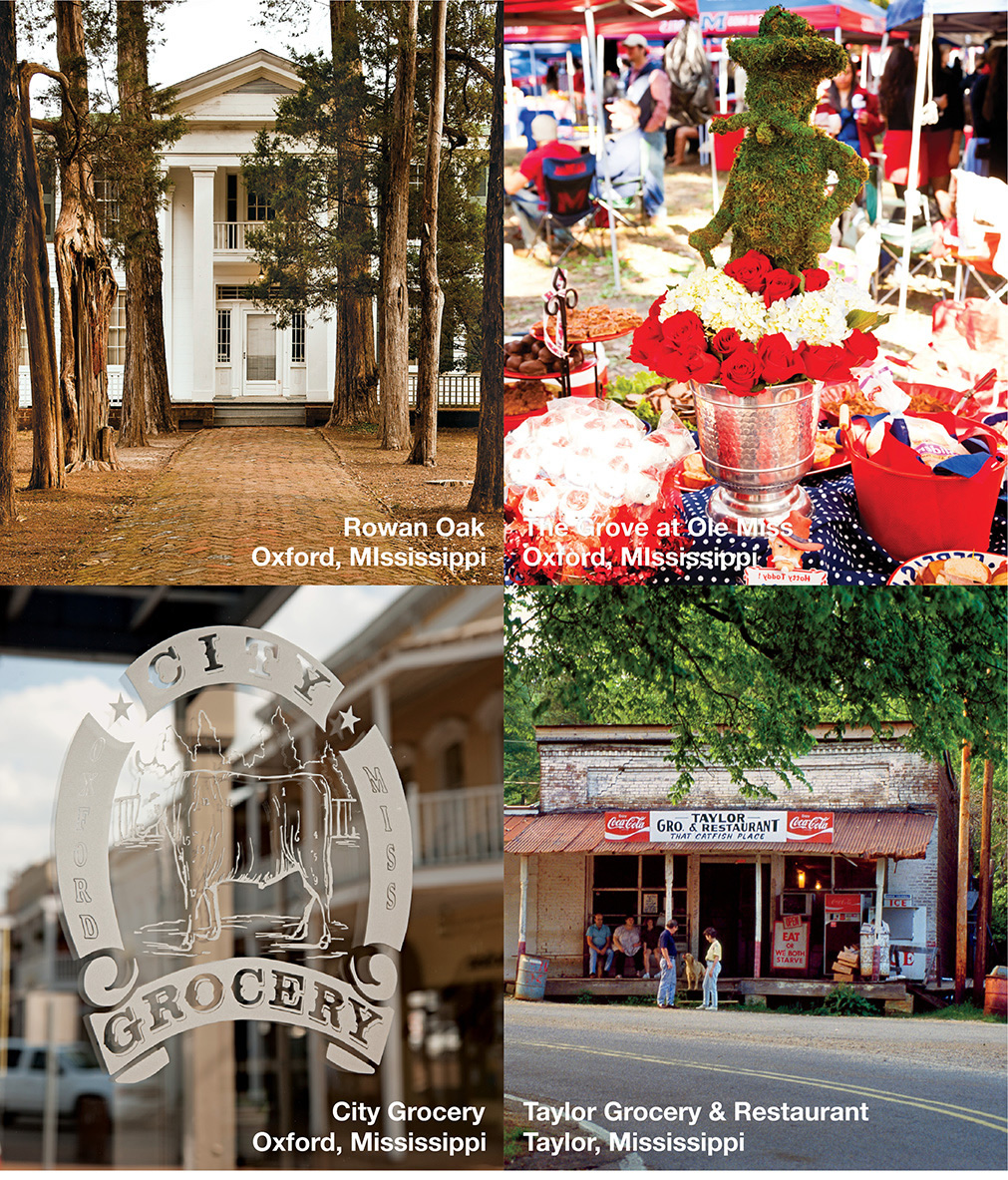
Thanks largely to The University of Mississippi, Oxford enjoys a perfect storm of three major Southern pastimes: literature, football, and food.

Its skyscraper-peppered downtown is notable as the home of Centennial Olympic Park (created for the 1996 games) and for the fact that it’s open only as long as a typical business day: In Atlanta, folks may work downtown, but they don’t live there.
Atlanta’s list of noteworthy neighborhoods feels endless because there are so many, but some are more famous outside the city’s borders than others. One is Midtown, a once down-and-out area that’s enjoying a magnificent architectural and cultural revival—all restored antebellum homes, art galleries, cafes, and multicultural throngs.
Another is the Virginia Highland area, a series of walkable streets lined with antique joints, boutiques, and agreeably twee Southern bars (think boiled peanuts, tin roofs, PBR in the can, and a combination of Lynyrd Skynyrd and Mumford & Sons on the jukebox).
And, of course, there is the dogwood-strewn Inman Park, an “in town” neighborhood listed on the National Register of Historic Places and one of the nation’s oldest “garden suburbs.” Its venerable neighborhood association bills Inman Park as Atlanta’s first “official planned community.”

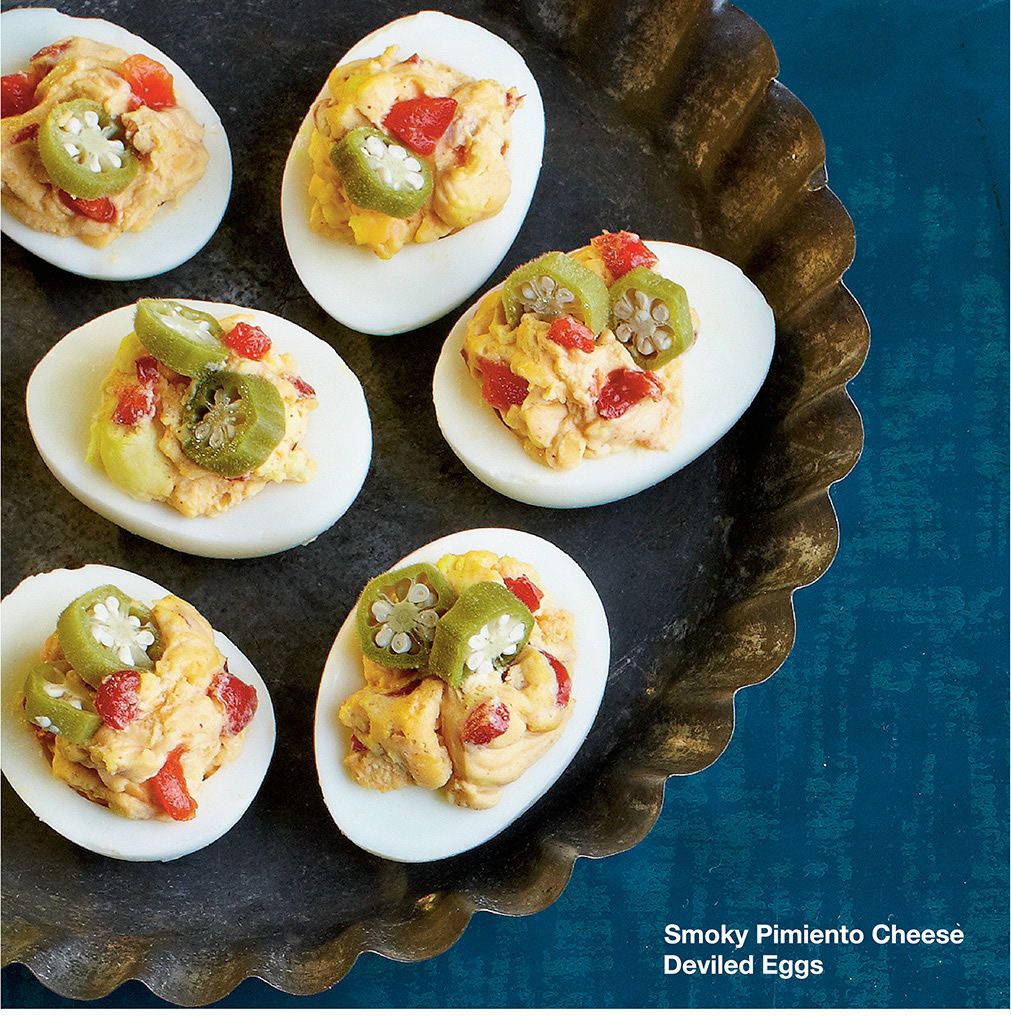
~ A Recipe from a Local ~
Smoky Pimiento Cheese Deviled Eggs
This dish combines two Dixie favorites—deviled eggs and pimiento cheese.
Makes 2 dozen Hands-On Time: 20 min. Total Time 35 min.
12 large eggs
1/4 cup mayonnaise
3/4 cup freshly grated smoked or sharp Cheddar cheese
1/4 cup finely chopped jarred roasted red bell pepper
1 Tbsp. Dijon mustard
Pinch of ground red pepper
Toppings: sliced green onions, diced country ham, sliced pickled okra, spiced pecans
1. Place eggs in a large stainless steel saucepan (not nonstick). Add water to depth of 3 inches. Bring to a rolling boil; cook 1 minute. Cover, remove from heat, and let stand 10 minutes. Drain.
2. Place eggs under cold running water until cool enough to handle. Peel under cold running water. Cut eggs in half lengthwise; remove yolks. Reserve 6 yolks for another use.
3. Mash remaining 6 yolks with mayonnaise using a fork. Stir in cheese and next 3 ingredients. Season with salt and pepper to taste. Spoon into egg whites. Serve with desired toppings.
Chef and Owner Jason Hill, Wisteria Restaurant
Atlanta, Georgia
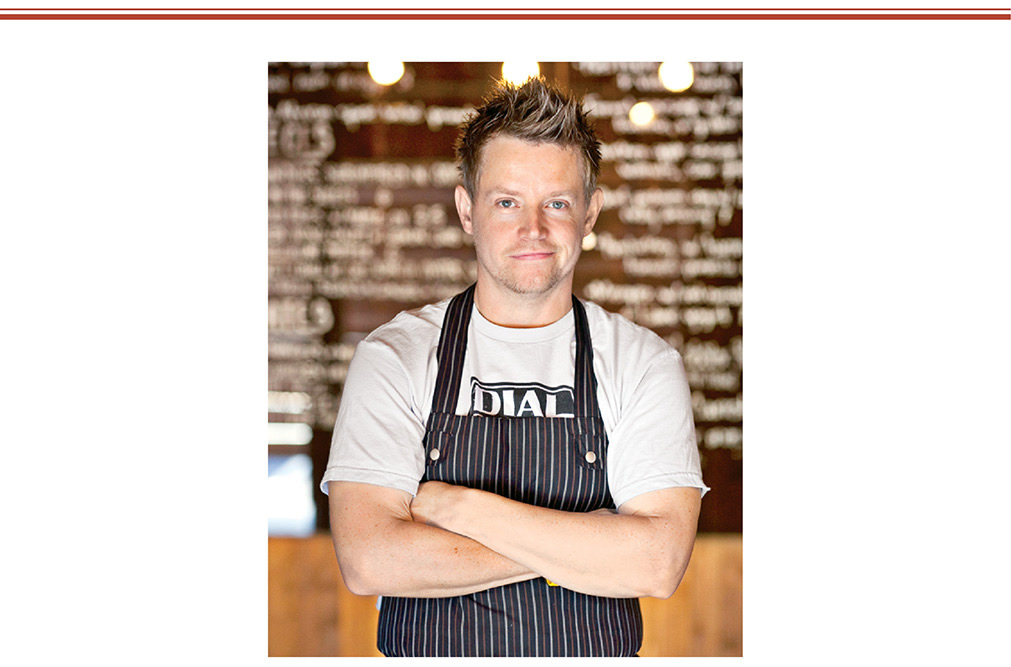
Meet Chef
Richard Blais
He also won his way into the hearts of the show’s fervent viewers, thanks to his edgy faux-hawk haircut, his utterly earnest desire to win, and his love of liquid nitrogen and other modern food innovations.
A big man around town these days, Blais operates some of Atlanta’s most popular eateries—his fine dining restaurant The Spence, his hipster bistros HD1 (Haute Doggery, for gourmet homemade hot dogs), and his Flip Burger Boutiques (Krispy Kreme milk shake, anyone?). But he’s careful to point out that he got his start cooking as a teenager in a McDonald’s on his native Long Island.
As Blais grew up, he never outgrew his passion for restaurant life and for cooking, putting himself through the Culinary Institute of America and eventually interning in some of the most well-known restaurants in the world, including The French Laundry, Daniel, and El Bulli.
Blais lives in Atlanta with his wife, Jazmin, and their two daughters.

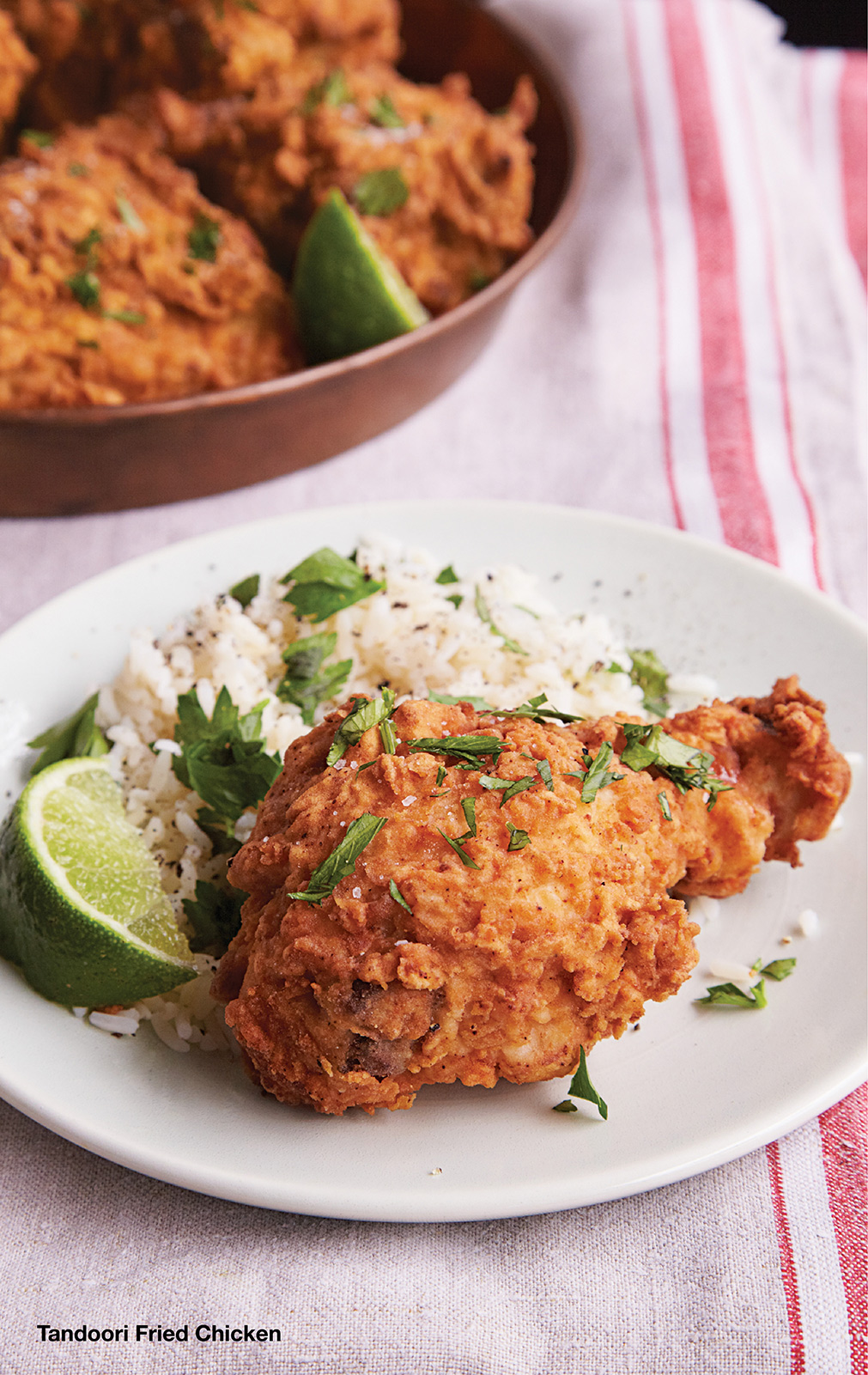
“I love tandoori chicken, but to me it lacks a bit of texture; I love classic fried chicken, which has plenty of texture but not a lot of spice. When you combine these dishes, I think they’re even better.” —Richard Blais
Tandoori Fried Chicken
Makes 4 to 6 servings Hands-On Time 45 min. Total Time 3 hours, 15 min., plus 1 day for marinating
1 (5-lb.) free-range whole chicken
1 cup kosher salt
2 Tbsp. light brown sugar
6 Tbsp. tandoori spice blend, divided
2 cups Greek yogurt
1/4 cup raspberry or apple cider vinegar
Peanut or vegetable oil
2 1/2 cups all-purpose flour
1 tsp. ground white pepper
1/2 tsp. freshly ground black pepper
Kosher salt
2 Tbsp. chopped fresh cilantro
2 Tbsp. chopped fresh flat-leaf parsley
2 limes, cut into wedges
1. Cut chicken into 8 pieces. Cut breasts crosswise through the bone into 3 equal pieces each.
2. Heat 2 cups water in a small saucepan over medium-high heat. Add 1 cup kosher salt, brown sugar, and 2 Tbsp. tandoori spice blend, stirring until salt and sugar dissolve. Pour into a large nonreactive bowl or container. Add 6 cups water; let stand until room temperature (about 15 minutes). Add chicken pieces; cover and chill 2 hours.
3. Drain chicken in a colander; discard liquid. Add yogurt, raspberry vinegar, and 2 Tbsp. Tandoori spice blend to bowl, whisking until well blended. Add chicken pieces, tossing to coat. Cover and chill 3 to 24 hours.
4. When ready to fry, remove chicken from the refrigerator, and let stand at least 30 minutes. Pour oil to depth of 3 inches into an 8-qt. Dutch oven; heat to 325°.
5. Stir together flour, white pepper, black pepper, and remaining 2 Tbsp. tandoori spice blend in a small bowl. Shake or brush excess yogurt mixture from chicken, reserving mixture. Dredge chicken in flour mixture, and shake off excess; dip in reserved yogurt mixture to coat, and shake off excess; dredge in flour mixture once more, and shake off excess.
6. Fry chicken, in batches, turning often and keeping the oil temperature at 325° until skin is golden brown, juices run clear, and a meat thermometer inserted in the thickest portion registers 165° (10 to 12 minutes for white meat, 13 to 15 minutes for dark meat).
7. Sprinkle chicken with kosher salt while still hot. Place cooked chicken on a wire rack in a jelly-roll pan, and keep warm in a 200° oven. Just before serving, sprinkle with cilantro and parsley. Serve with lime wedges.
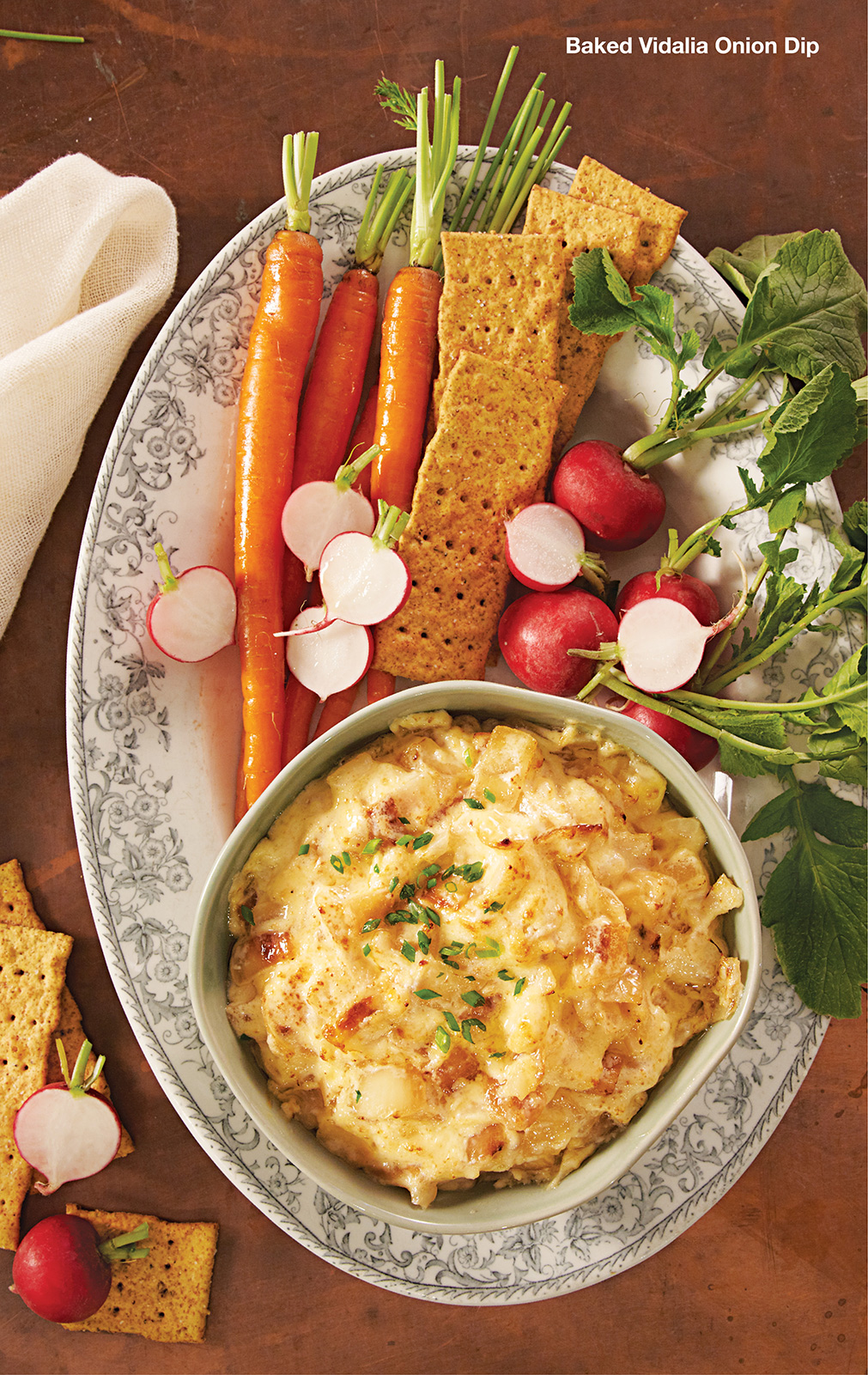
Baked Vidalia Onion Dip
Makes 6 cups Hands-On Time 15 min. Total Time 50 min.
2 Tbsp. butter
3 large Vidalia onions, coarsely chopped
2 cups (8 oz.) shredded Swiss cheese
2 cups mayonnaise
1 (8-oz.) can sliced water chestnuts, drained and chopped
1/4 cup dry white wine
1 garlic clove, minced
1/2 tsp. hot sauce
Garnish: chopped fresh chives
Whole-grain crackers and trimmed fresh vegetables such as carrots and radishes
1. Preheat oven to 375°. Melt butter in a large skillet over medium-high heat; add onion, and sauté 10 minutes or until tender.
2. Stir together shredded Swiss cheese and next 5 ingredients; stir in onion, blending well. Spoon mixture into a lightly greased 2-qt. baking dish.
3. Bake at 375° for 25 minutes, and let stand 10 minutes. Serve with whole-grain crackers and trimmed fresh vegetables.

~ You've Gotta Try ~
Vidalia Onions
According to federal regulations and state law, only the mild yellow onions grown in a 20-county area of Georgia can rightly be called Vidalias.
When first discovered in the 1930s, they seemed another blow to already depressed Depression-era farmers: Even their onions lacked zip! But people across the South soon began asking for the sweet onions from the region.
The low-in-sulfur soil in and around Vidalia, about three hours southeast of Atlanta, is what gives them their signature sweetness. And though the onions grow only in Georgia, variations of this baked dip abound throughout the South.


Experience
the Cyclorama
Like a Local
Painted in the late 1800s by German artists employed by the Wisconsin-based American Panorama Company, the circular panoramic artwork aimed for realism from the outset. The artists visited the battlefield, studied the landscape, and interviewed both Union and Confederate soldiers about their experiences.
Since 1893 it has been displayed in the Grant Park neighborhood, and Atlantans have been paying to sit before it and take it in since 1898. Admission was a dime a person back then; now adults pay 10 bucks. But today’s Cyclorama experience comes with some upgrades: The seats move you along its full circumference, and there’s a nifty 14-minute movie narrating the experience.
It is a living history lesson, a visual and intellectual experience of a city’s darkest hour, and a tourist attraction that even real Atlantans come back to visit again and again.


Meet Chef
Kevin Gillespie
Gillespie received his culinary training at the Art Institute of Atlanta, from which he graduated with honors. Apart from the 18-or-so months he spent at the stove of the acclaimed restaurant Fife in Portland, Oregon, he’s been a mainstay in Atlanta’s kitchens.
Gillespie recently transitioned from being head chef of Atlanta’s Woodfire Grill to being chef-owner of his new spot, Gunshow. He is author of the cookbook Fire in My Belly.

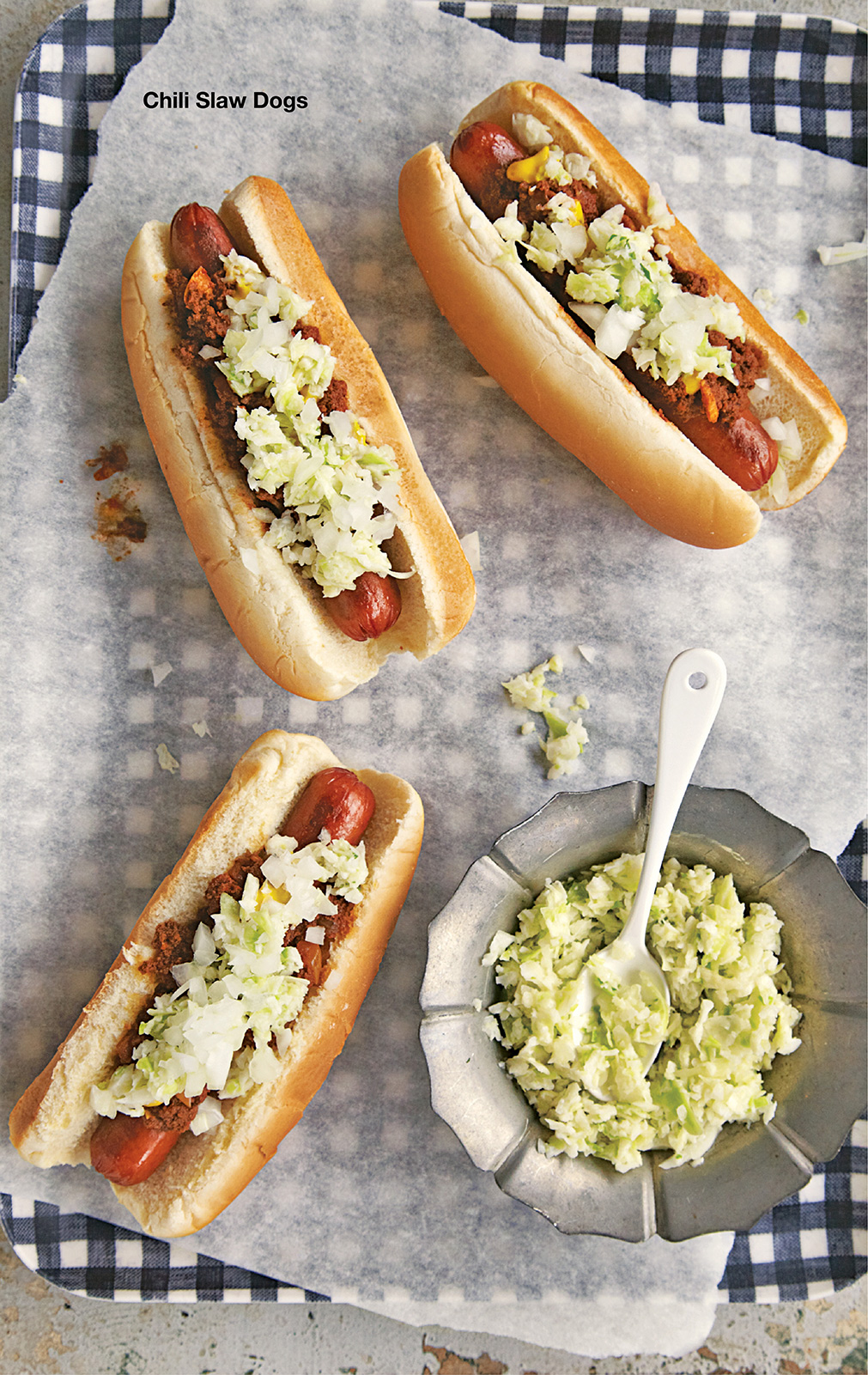
“When my mom was pregnant with me, she craved hot dogs from The Varsity, a fast-food institution in Atlanta. She ate Varsity dogs for nine months straight. Those chili dogs are in my blood.” —Kevin Gillespie
Chili Slaw Dogs
The order of the ingredients matters: You want to enclose the mustard in the chili and slaw so it’s almost a surprise within the bite.
Makes 8 servings Hands-On Time 1 hour, 5 min. Total Time 3 hours, 5 min.
1 tsp. canola oil
8 beef hot dogs
8 hot dog buns (unsliced or sliced for top-loading)
Yellow mustard
2 cups Slaw
1/2 cup finely diced Vidalia onion
1. Heat a 10-inch cast-iron skillet over high heat, and carefully wipe the pan with a paper towel dipped in canola oil (you want only enough oil to shine up the skillet). When the skillet is smokin’ hot, pat the dogs dry, and add them to the skillet. Reduce heat to medium, and cook 8 minutes or just until the dogs are lightly charred, turning occasionally. Slice the buns lengthwise through the top (if not already sliced), but don’t cut all the way through. Slip in the dogs, spoon a generous amount of Hot Dog Chili onto each dog, and squeeze a generous amount of mustard down the length of the chili. Top each with 1/4 cup Slaw and a thick layer of onion.
1 lb. 85% lean grass-fed ground beef
1 cup diced Vidalia onion
3 Tbsp. New Mexico red chile powder
3 Tbsp. tomato paste
1 tsp. table salt
5 garlic cloves, peeled and sliced very thin
1 cup beer
1. Stir together beef, onion, chile powder, tomato paste, salt, garlic, and 1 cup water. The mixture will be thick and pasty. Cook over medium-high heat 12 minutes or until most of the liquid evaporates, stirring often. Add beer, and return chili to a simmer. Reduce heat to medium-low, and simmer 25 more minutes, stirring often. Remove from heat, and cool in pan (about 1 hour). (This is a weird technique because there is no caramelization or browning of the meat, but it achieves the perfect texture and consistency for hot dog chili with no big chunks of meat.)
Slaw
What you don’t use on the dogs will keep in the fridge up to three days.
Makes about 3 1/2 cups Hands-On Time 10 min. Total Time 1 hour
1/2 small head green cabbage, dark outer leaves removed (about 1 1/2 lb.)
3 Tbsp. sugar
1 1/2 tsp. table salt
2 Tbsp. mayonnaise
1. Cut cabbage into coarse chunks, and drop into a food processor fitted with the metal blade. Give it about 20 quick pulses. (You want a very fine chop but not mush; you should have a little more than 2 1/2 cups chopped cabbage.) Scrape cabbage into a bowl, and mix in sugar and salt. Press and pack the mixture down to compact it, and then cover and refrigerate for 50 minutes to 1 hour so the sugar and salt dissolve and start to draw the liquid out of the cabbage.
2. Press the mixture in a fine-mesh strainer, and discard the liquid. Return cabbage mixture to bowl; stir in mayonnaise until combined.
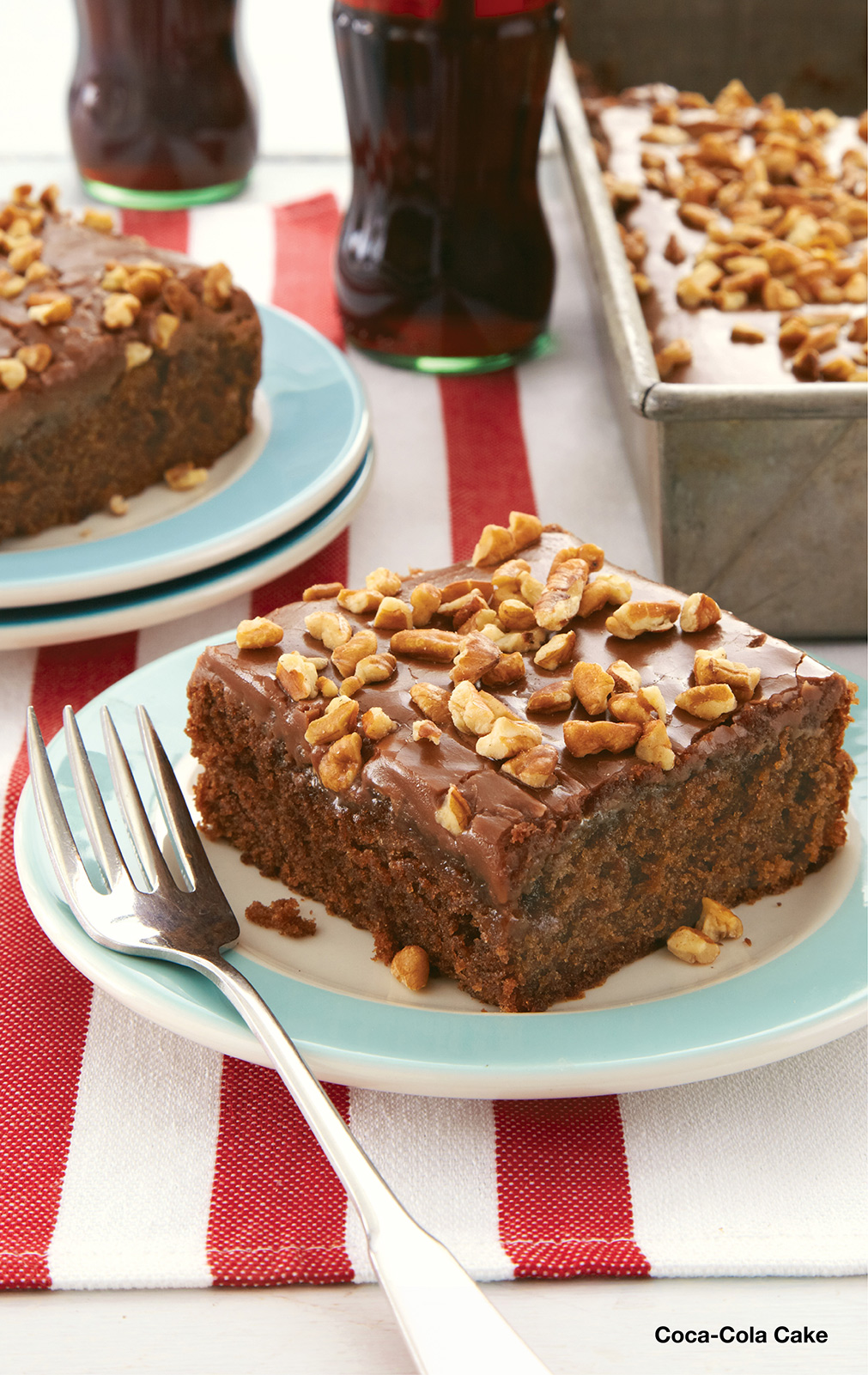

~ You've Gotta Try ~
Coca-Cola Cake
In Atlanta, where Coca-Cola is headquartered, and across much of the South, where just about any carbonated beverage is referred to as “a Coke,” cooks don’t hesitate to use the sweet brown liquid as an ingredient.
It turns up in red-eye gravies, meat marinades and barbecue sauces, cocktails, ice-cream concoctions, and perhaps most famously in the sweet and moist chocolate sheet cake known simply as a Coca-Cola cake.
Many variations abound, but this one is a Southern Living favorite.

Coca-Cola Cake
This is simply one of the best sheet cakes on earth. The magical brew of carbonated cola is the secret to its tender texture.
Makes 12 servings Hands-On Time 15 min. Total Time 55 min.
1 cup Coca-Cola
1/2 cup buttermilk
1 cup butter, softened
1 3/4 cups sugar
2 large eggs, lightly beaten
2 tsp. vanilla extract
2 cups all-purpose flour
1/4 cup cocoa
1 tsp. baking soda
1 1/2 cups miniature marshmallows
3/4 cup chopped pecans, toasted
1. Preheat oven to 350°. Combine Coca-Cola and buttermilk; set aside.
2. Beat butter at low speed with an electric mixer until creamy. Gradually add sugar; beat until blended. Add eggs and vanilla; beat at low speed until blended.
3. Combine flour, cocoa, and baking soda. Add to butter mixture alternately with cola mixture, beginning and ending with flour mixture. Beat at low speed just until blended.
4. Stir in marshmallows. Pour batter into a greased and floured 13- x 9-inch pan. Bake at 350° for 30 to 35 minutes. Remove from oven; cool 10 minutes. Pour Coca-Cola Frosting over warm cake. Sprinkle with pecans.
Note: Don’t make the frosting ahead—you need to pour it over the cake shortly after baking.
1/2 cup butter
1/3 cup Coca-Cola
3 Tbsp. cocoa
1 (16-oz.) package powdered sugar
1 Tbsp. vanilla extract
1. Bring first 3 ingredients to a boil in a large saucepan over medium heat, stirring until butter melts. Remove from heat; whisk in sugar and vanilla.

Meet Author
Susan Rebecca White
Author of the critically acclaimed novels A Soft Place to Land and Bound South, White completed her third novel, A Place at the Table, this year.
In the new novel, the character Bobby Banks’s grandmother, ‘Meemaw,’ makes such a good pound cake that she sells 10 of them a week out her back door. Women in her neighborhood have a standing order so they can always have pound cake on hand.
White doesn’t have a meemaw known for her pound cake, but her friend Greg Johnson’s grandmother, Mittie Cumbie Wade of Cairo, Georgia, was famous for hers. He shared it with her. She shares it here.

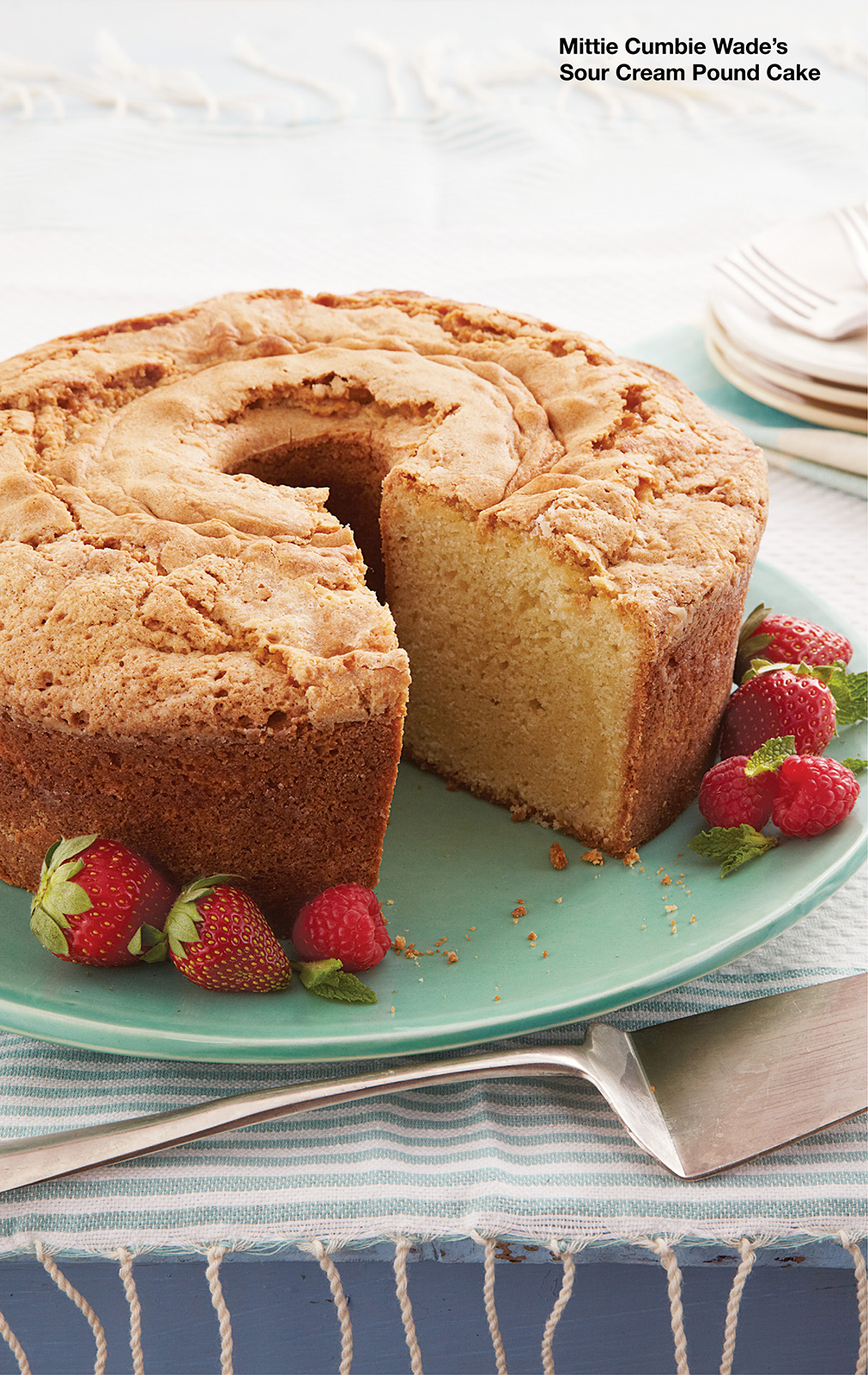
“I bake this cake regularly. It is so good with a cup of hot coffee. The cake has a rich, buttery crumb, but the best part is its crackly, sugar-cookie-like crust.” —Susan Rebecca White
Mittie Cumbie Wade’s Sour Cream Pound Cake
Makes 16 servings Hands-On Time 15 min. Total Time 4 hours, 15 min.
1 cup unsalted butter, at room temperature
3 cups sugar
6 large eggs, at room temperature
1 tsp. good-quality vanilla extract
1/4 tsp. kosher salt
3 cups all-purpose flour
1/2 tsp. baking soda
1 cup sour cream
1. Preheat oven to 325°. Butter and flour a 10-inch (16-cup) tube pan.
2. In a stand mixer, cream together butter and sugar. Add eggs, 1 at a time, beating well after each addition. Add vanilla extract and salt.
3. Stir together flour and baking soda, and then add dry ingredients to wet ingredients, mixing just until about half mixed.
4. Add sour cream. Mix until all ingredients are combined and batter looks creamy, but don’t overmix.
5. Pour into prepared pan, and bake on center rack at 325° for 1 hour and 25 minutes. Cool in pan 10 minutes. Cool completely on rack (about 2 hours).
Note: Room temperature butter and eggs are a must for this cake. You can speed up the process by placing the eggs in a bowl of warm water for 10 to 20 minutes, and microwaving the butter at LOW for 10 to 20 seconds.

Founded before neighboring Atlanta, Decatur was named for the American war hero Stephen Decatur, a popular commanding naval officer who fought magnificently in the War of 1812. (Oddly enough, he was born in Maryland, and at least nine states, none of them Maryland, have cities named after him.) Georgia’s Decatur was incorporated in 1823.
A splendid old courthouse anchors Decatur’s historic downtown square, at the intersection of Clairmont Road and Ponce de Leon Avenue, and the blocks around it are thronged with antebellum brick homes, bungalows, and cottages, many lovingly refurbished. This incredibly walkable city of 19,000 residents has attracted more than 80 restaurants—from New Orleans-style sno-cone stands to the New York Times-lauded fine dining establishment Cakes & Ale—and earned it a place among the South’s tastiest towns.
It helps that Decatur is an artistic community: Eddie’s Attic, a venerable music venue on the square, is the place where John Mayer and acts like the Indigo Girls and Sugarland got their starts. Decatur is also home to “Your Dekalb Farmers Market,” which is less a traditional collection of farmstands and more an international food market in the vein of the great European food halls. Offering its own branded products in addition to local and exotic produce, spices and condiments from all over the world, an amazing assortment of Fair Trade coffees, and more than 400 varieties of cheese, it’s an impressive market in one of the South’s most impressive hometowns.


Farmers’ Market Pizza
Decatur’s Dekalb Farmers Market inspired the vegetable medley for this pizza.
Makes 6 servings Hands-On Time 30 min. Total Time 1 hour, 50 min.
Plain white cornmeal
1 lb. bakery pizza dough
1/2 to 3/4 cup Quick Tomato Sauce
1 (8-oz.) package sliced fresh mozzarella cheese
1/4 lb. mild Italian sausage, cooked and crumbled
1 1/2 cups Farmers’ Market Roasted Vegetables
1. Preheat oven to 500°. Heat a pizza stone or baking sheet in oven 30 minutes.
2. Meanwhile, lightly dust a second baking sheet with cornmeal. Stretch pizza dough into a 12- to 14-inch circle on baking sheet.
3. Spread Quick Tomato Sauce over dough. Top with mozzarella slices and Italian sausage. Arrange Farmers’ Market Roasted Vegetables over pizza; season with kosher salt and freshly ground black pepper to taste.
4. Slide pizza from baking sheet onto hot pizza stone or baking sheet in oven. Bake at 500° for 15 minutes or until crust is thoroughly cooked, edges are golden, and cheese melts.
1 (28-oz.) can whole peeled tomatoes with basil
1 1/2 Tbsp. extra virgin olive oil
1 tsp. kosher salt
1. Stir together tomatoes, olive oil, and salt. Process with a handheld blender until smooth.
1 medium eggplant, cut into 1-inch pieces
2 large red bell peppers, cut into 1-inch pieces
1 fennel bulb, cut into 1/4-inch slices
3 garlic cloves, thinly sliced
3 Tbsp. extra virgin olive oil
1 tsp. kosher salt
1/2 tsp. freshly ground black pepper
2 Tbsp. chopped fresh basil
1 Tbsp. white balsamic vinegar
1. Preheat oven to 450°. Toss together first 7 ingredients in a bowl until coated. Spread eggplant mixture in a single layer in a 15- x 10-inch jelly-roll pan. Bake 45 to 50 minutes or until vegetables are tender and slightly charred, stirring halfway through. Cool slightly (about 10 minutes). Toss with basil and vinegar. Serve immediately. Store in an airtight container in refrigerator up to 2 days.

~ A Recipe from a Local ~
Butternut Squash Bake
Each fall, people across the South decorate their homes with pretty gourds and their tables with delicious squash dishes. This scrumptious side, perfect for a holiday dinner with roasted turkey or pork, has a soufflé-like quality.
Makes 4 to 6 servings Hands-On Time 25 min. Total Time 1 hour, 30 min
Roasted Winter Squash, coarsely chopped
3/4 cup egg substitute
2 Tbsp. butter, melted
2 Tbsp. frozen orange juice concentrate, thawed
2 Tbsp. honey
1/8 tsp. table salt
Dash of ground nutmeg
1. Preheat oven to 350°. Toss together chopped roasted squash and remaining ingredients in a large bowl. Process mixture, in batches, in a blender or food processor until smooth, stopping to scrape down sides. Pour mixture into a lightly greased 1 1/2-qt. baking dish.
2. Bake at 350° for 35 to 40 minutes or until mixture is set.
3 lb. butternut squash
1 Tbsp. butter, melted
1/2 Tbsp. honey
1/4 tsp. table salt
1/4 tsp. black pepper
1. Preheat oven to 450°. Remove stem from squash. Cut squash in half lengthwise; remove and discard seeds. Cut each half into 4 wedges, and place on an aluminum foil-lined jelly-roll pan.
2. Stir together butter and honey until blended. Brush squash evenly with butter mixture; sprinkle evenly with salt and pepper.
3. Bake at 450° for 30 to 35 minutes or until tender, turning once. Cut skins from squash wedges, and discard.
Dorothy Roberts
Hiawassee, Georgia
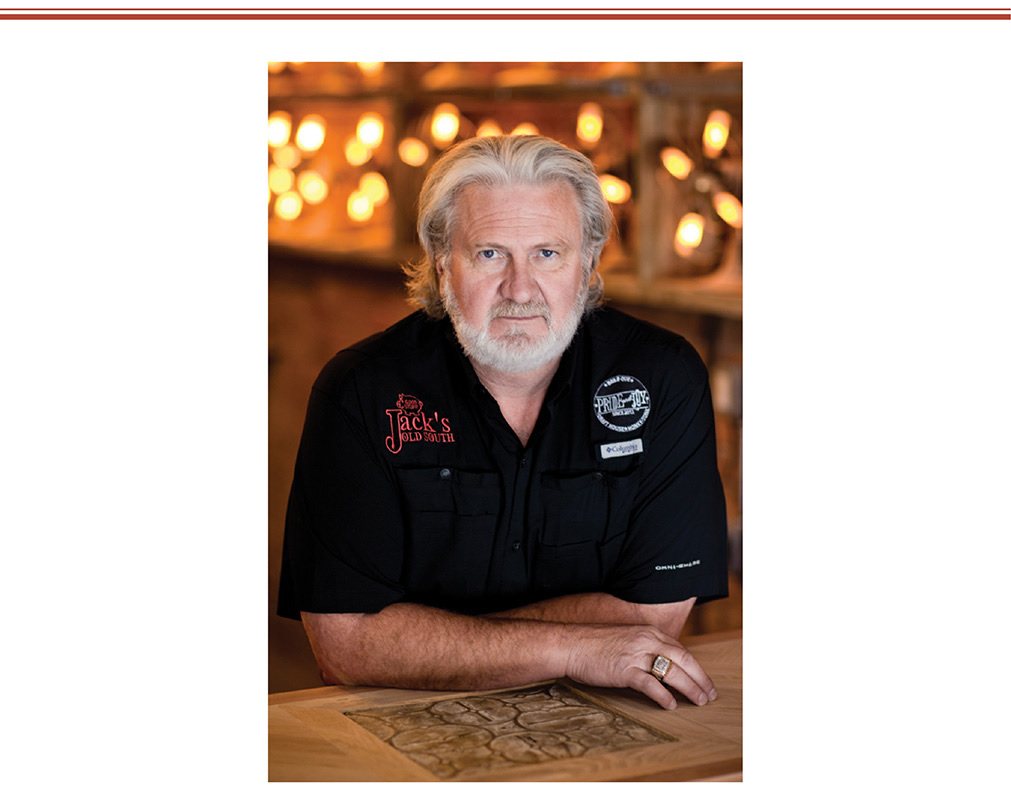
Meet Pitmaster
Myron Mixon
Raised in Vienna, Georgia, Mixon helped his father, Jack, run a barbecue restaurant that featured Jack’s Old South BBQ Sauce. After his father died in 1996, Mixon figured that competing in barbecue contests could help the family business sell some sauce.
He has won more than 180 grand championships, 30 state championships, 11 national championships, and more than 1,800 barbecue trophies. The chief cook of the Jack’s Old South Competition Bar-B-Que Team, the star of Destination America’s BBQ Pitmasters and CBS’s Ultimate Barbecue Showdown, he is author of the New York Times best-selling cookbook Smokin’ with Myron Mixon.
The owner of the popular Pride and Joy barbecue restaurants in Miami and New York, he is widely recognized not only as the most successful man in barbecue but also one of the most charismatic. He lives in Unadilla, Georgia, and abides by the motto: “Barbecue is a simple food. Don’t mess it up.”

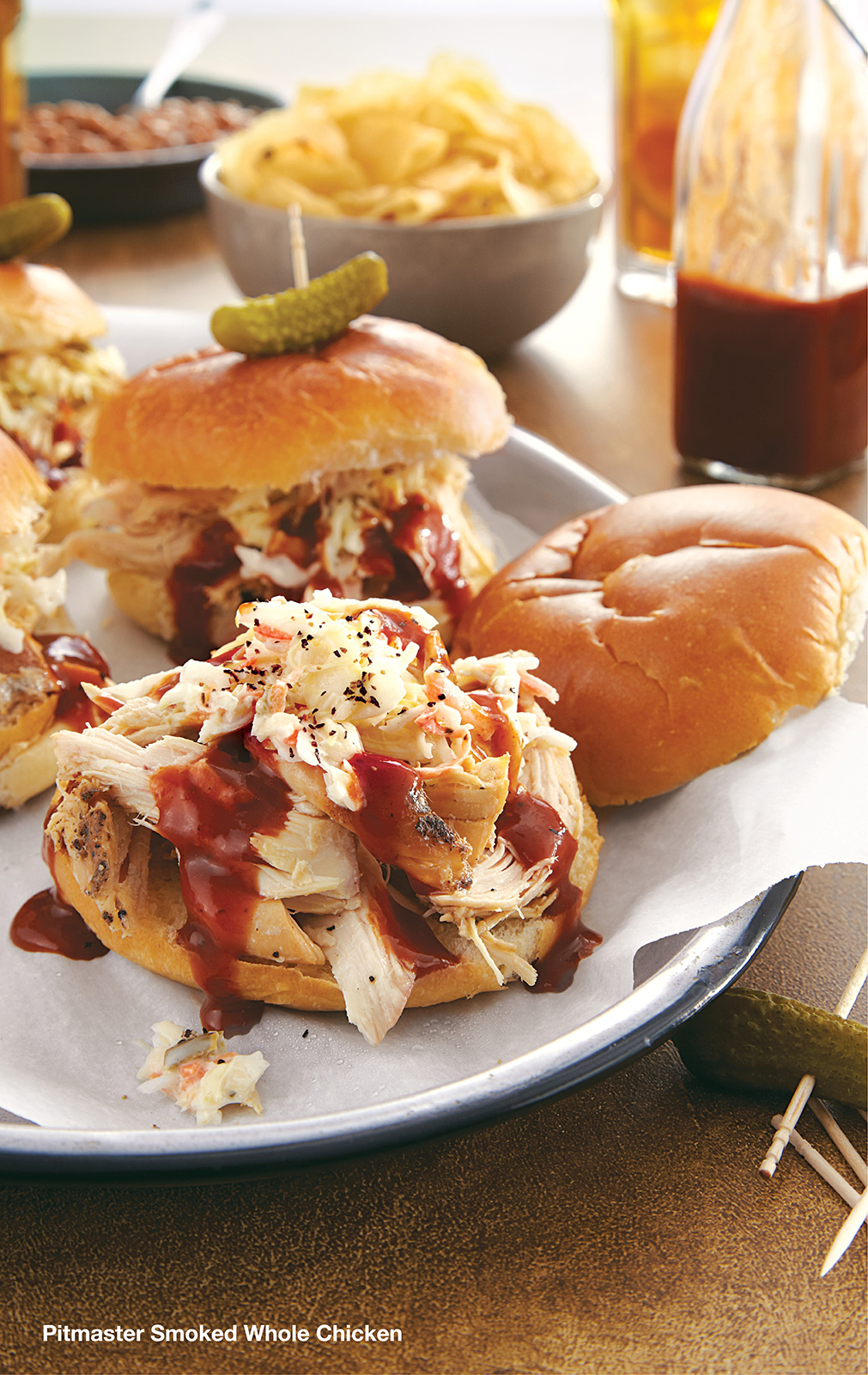
“Smoking a whole chicken is probably the easiest thing you can master. My solution to never having dry chickens: a small pan of apple juice. It steams up and circulates, keeping the meat tender and ensuring a melt-in-your-mouth texture.” —Myron Mixon
Pitmaster Smoked Whole Chicken
The skin on this chicken is delicious and soft enough to bite through. If you prefer crunchy skin, you should make yourself some fried chicken instead.
Makes 4 servings Hands-On Time 20 min. Total Time 3 hours, 20 min., plus 1 day for marinating
1 (3 1/4-lb.) whole chicken, giblets removed
4 cups chicken broth
1 (1-oz.) envelope dry onion soup mix
2/3 cup chili powder
1/2 cup sugar
1/4 cup kosher salt
1/4 cup onion powder
1/4 cup garlic powder
1 tsp. ground red pepper
2 cups apple juice
1. Rinse the chicken inside and out, and pat it dry thoroughly. Stir together the chicken broth and dry onion soup mix in a deep bowl. Add the chicken to the bowl, coating it well with the mixture; marinate it, covered, in the refrigerator overnight. In a small bowl, combine the chili powder and next 5 ingredients to make a rub.
2. Preheat a charcoal grill or a smoker to about 250° (medium-low) heat. Remove the chicken from the bowl, and discard the marinade. Pat chicken dry with paper towels. Sprinkle rub liberally on chicken, patting to adhere (you can store any unused rub in an airtight container up to 1 year). Place the chicken, breast side up, on a meat rack inside a 13- x 9- x 2-inch disposable aluminum pan (be sure the rack raises the bird above the surface of the pan). Pour the apple juice into another disposable pan or into your smoker’s water pan.
3. Bank ashed-over charcoals on the left and right sides of the grill, and place the pan of apple juice between the banked coals or on the water-pan shelf of your smoker. Place the pan with the chicken on the center of the grill grates, above the apple juice, or on the top shelf of the smoker. Cover and cook, maintaining heat at 225° to 250°, for 2 hours and 45 minutes or until a meat thermometer inserted into the thickest portion of the breast meat registers 165°.
4. Remove chicken from grill or smoker, and let rest, loosely covered with foil, 15 minutes. Quarter the chicken—or, for sandwiches, pull the meat from the bones, and serve on buns with hickory sauce, creamy coleslaw, and sliced pickles.

The band formed here in 1980 when singer Michael Stipe met guitarist Peter Buck at the Wuxtry Records store—which still stands today—and has since cemented Athens’ coolness. Rolling Stone bolstered that reputation when it called Athens the top college music scene in America.
What did you think of second? The University of Georgia (go, Bulldogs!), naturally. Chartered in 1785 and opened in 1801, it was America’s first state college. Situated just below the start of the Blue Ridge Mountains and about 70 miles east of Atlanta, Athens is home to the university’s more than 30,000 students and about 60,000 other folks.
The combination of college students and music is one thing, but Athens has more to be proud of, including significant architectural and botanical attractions. Because Athens was located enough outside of General Sherman’s path to almost entirely avoid Civil War damage, it is now an amazing place to enjoy antebellum Victorian and Federal architecture, boasting 15 neighborhoods on the National Register of Historic Places. Athens is also home to the state botanical gardens, a 313-acre preserve with 5 miles of nature trails, and the University of Georgia’s Trial Gardens.
Coffee shops, such as local favorite Jittery Joe’s, abound. For restaurants, there’s Weaver D’s, a 27-year-old soul-food restaurant immortalized in R.E.M.’s 1992 album Automatic for the People (the phrase is one of owner Dexter Weaver’s mottos, with which he sometimes answers the phone). It’s a place where you can get fried chicken, pork chops, macaroni and cheese, and the like.
Athens also has produced one very serious star chef, Hugh Acheson. A judge on Top Chef, he’s a good example of an outsider-turned-ultimate insider. The Ottawa, Canada, native trained in San Francisco’s top fine-dining spots before following his wife to Athens, where he opened his own restaurant, Five & Ten, in 2000. Using vintage Southern Junior League cookbooks for inspiration, he brought a modern and minimalist approach to Southern dishes, reminding diners that Southern cuisine is as connected to fresh vegetables as it is to deep-fried foods.
Acheson’s fresh take on Southern favorites was a smash from Five & Ten’s opening night—when Stipe was among the guests. Shortly after, Food & Wine named Acheson a “Best New Chef.” He has since opened The National, a Mediterranean-inflected eatery in Athens, and the handsomely quirky Empire State South in Atlanta.
If you’re hoping to spot other rock stars (or new music legends in the making) in Athens, you might try The Grit, a legendary vegetarian restaurant that’s attracted band types since it opened here in 1986. Stipe wrote “Welcome to the Occupation” at The Grit, and the R.E.M. video dance sequence for “The One I Love” was filmed in it. The Grit is known for its free-spirited, free-wheeling crowd and entrées like the Golden Bowl, homemade tofu served over brown rice and topped with sautéed veggies, cheese, and a Worcestershire and soy sauce-laced concoction called Grit Yeast Gravy.
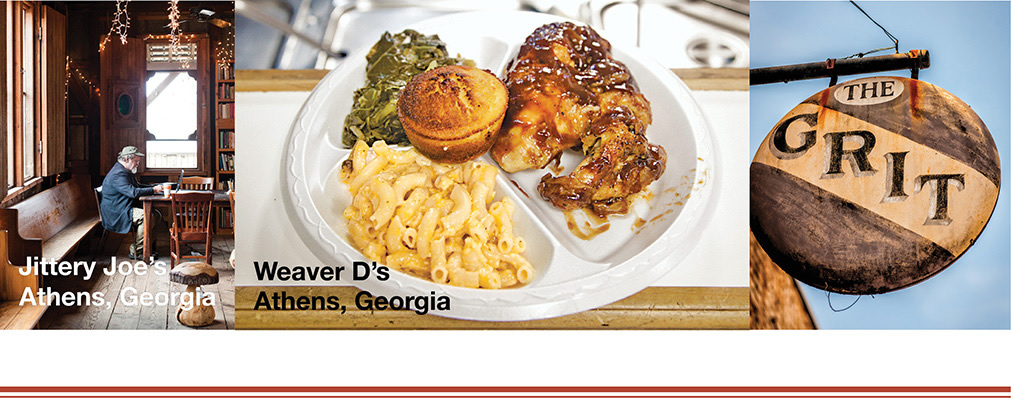

~ A Recipe from a Local ~
Grilled Pork Porterhouse with Peach Agrodolce
Agrodolce, a traditional Italian sweet-and-sour sauce made with vinegar and sugar (or sweet ingredients such as peaches and raisins), adds fresh summer flavor to the granddaddy of all pork chops.
Makes 4 servings Hands-On Time 15 min. Total Time 1 hour, 25 min.
4 (1 1/2-inch-thick) pork porterhouse chops (about 2 1/2 lb.)
1 Tbsp. olive oil
3/4 tsp. kosher salt
1/2 tsp. freshly ground black pepper
1. Let pork stand at room temperature 30 minutes. Light one side of grill, heating to 350° to 400° (medium-high) heat; leave other side unlit. Brush pork with olive oil, and sprinkle with salt and pepper.
2. Grill pork over lit side of grill, covered with grill lid, 4 minutes on each side; transfer pork to unlit side, and grill, covered with grill lid, 10 minutes on each side or until a meat thermometer registers 150°. Let stand 5 minutes. Arrange pork on a serving platter, and top with Peach Agrodolce.
2 Tbsp. raisins
2 Tbsp. tawny port wine
1 Tbsp. chopped fresh parsley
1 Tbsp. balsamic vinegar
1 Tbsp. olive oil
2 large fresh, ripe peaches, peeled and diced into 1-inch pieces
1. Cook raisins, port, and 2 Tbsp. water in a small saucepan over medium heat, stirring occasionally, 5 minutes. Remove from heat; whisk in parsley, vinegar, and oil. Stir in peaches, and add salt and freshly ground pepper to taste.
Chef Hugh Acheson, Five & Ten
Athens, Georgia

Meet Songwriter
Matthew Sweet
Originally from Lincoln, Nebraska, Sweet arrived in Athens in 1983 to attend college and, he hoped, join in the local music scene. His breakthrough 1991 album Girlfriend, written in Athens, included a Top Ten single (the title track) that was on massive rotation on MTV.
Sweet writes and produces music now, has written songs for Hanson and with Susanna Hoffs of The Bangles, and still performs “Girlfriend” live.


“I remember taking out-of-town visitors to the Bluebird and having many a fine breakfast with members of R.E.M., Pylon, the B-52s, Oh-OK, and others. I still consider its Bulldog Tofu a classic.” —Matthew Sweet
Bluebird Cafe Bulldog Tofu Stir-Fry with Grits
Originally named the El Dorado, the Bluebird Cafe (now closed) was Athens’s oldest vegetarian restaurant. Back in the 1970s, many Athens musicians and artists hung out and drank coffee there.
Makes 4 to 6 servings Hands-On Time 35 min. Total Time 35 min.
GRITS
1/2 tsp. table salt
1 cup uncooked stone-ground yellow grits
21 Tbsp. butter
1/4 tsp. freshly ground black pepper
Nutritional yeast* (optional)
STIR-FRY
1 (14-oz.) package extra-firm tofu, drained
2 Tbsp. canola oil
1 onion, coarsely chopped
1 red bell pepper, sliced
4 garlic cloves, minced
1 Tbsp. minced fresh ginger
2 tomatoes, chopped
1/3 cup soy sauce
1/4 cup nutritional yeast
2 cups firmly packed fresh baby spinach
1. Prepare the Grits: Bring 4 cups water and salt to a boil in a medium saucepan; add grits. Reduce heat, and simmer, stirring constantly, 18 to 20 minutes. Add butter and pepper at the end. You can add a pinch of nutritional yeast to the grits, as well, for seasoning.
2. Prepare the Stir-Fry: Place tofu on layers of paper towels; cover with additional layers of paper towels. Weight the top with a dinner plate to release all of the moisture. (Sides of tofu should be bulging slightly but not cracking.) Let stand 10 minutes; discard paper towels. Cut into 1/2-inch cubes. Fry tofu in hot oil in a large skillet over medium-high heat, stirring often, 8 minutes or until browned on all sides. Remove to a paper towel-lined plate, reserving oil in skillet. Add onion, bell pepper, garlic, and ginger to skillet; sauté 6 minutes. Add tomato, and sauté 2 minutes. Add soy sauce and yeast; sauté 1 minute. Add spinach; sauté 1 minute. Serve over grits.
Note: We tested with Lewis Labs Brewer’s Yeast.

~ A Recipe from a Local ~
Peach Melba Shortcakes
The original Peach Melba, created by French chef Auguste Escoffier to honor Australian opera singer Nellie Melba in 1900, involved ice cream topped with poached peaches and a raspberry sauce. The term has long since been used to refer to any dessert that pairs peaches and raspberries. In Georgia and across Dixie, where both fruits grow in abundance, there’s no shortage of Peach Melba desserts.
Makes 8 servings Hands-On Time 30 min. Total Time 45 min.
2 1/2 cups all-purpose flour
1 Tbsp. plus 1 tsp. baking powder
1 tsp. table salt
7 Tbsp. sugar, divided
1/4 cup cold butter, cut into small cubes
1 large egg
1/2 tsp. vanilla extract
3/4 cup plus 1 Tbsp. half-and-half, divided
Parchment paper
6 large fresh, ripe peaches, peeled and sliced
1 Tbsp. fresh lemon juice
1 1/2 tsp. vanilla bean paste
2 pt. fresh raspberries
1/4 cup honey
1. Preheat oven to 425°. Combine first 3 ingredients and 1 Tbsp. sugar in a large bowl; cut in butter with a pastry blender or 2 forks until crumbly. Whisk together egg, vanilla extract, an 3/4 cup half-and-half; add to dry ingredients, stirring just until dry ingredients are moistened and dough comes together.
2. Turn dough out onto a lightly floured surface; roll or pat dough into a 7-inch circle (about 1 inch thick). Cut into 8 wedges; place on a parchment paper-lined baking sheet. Brush tops with remaining 1 Tbsp. half-and-half; sprinkle with 2 Tbsp. sugar.
3. Bake at 425° for 15 to 20 minutes or until golden. Meanwhile, stir together peaches, next 2 ingredients, and remaining 4 Tbsp. sugar in a bowl.
4. Cook raspberries and honey in a medium saucepan over medium-low heat 3 minutes, stirring with a fork to lightly crush berries. Spoon raspberry mixture onto 8 individual serving plates.
5. Split warm shortcakes in half horizontally. Place shortcake bottoms on top of raspberry mixture, and top with peaches and shortcake tops. Serve immediately with Sorghum Whipped Cream.
1 cup whipping cream
2 Tbsp. sorghum syrup
1. Beat whipping cream at high speed with an electric mixer until foamy; add sorghum syrup, and beat until soft peaks form.
Pastry Chef Shae Rehmel, Five & Ten
Athens, Georgia

Buttermilk Chess Tarts
These tiny takes on the traditional Southern chess pie are perfect for a party. Why chess? Some food historians theorize the name traces to similar English pies with a cheesy texture—“cheese pies”—and that somewhere along the line the word cheese morphed into chess. A more romantic Southern version holds that the name caught on when a thrifty baker was asked what she was cooking and answered simply, “Jes’ pie.”
Makes 5 dozen Hands-On Time 30 min. Total Time 1 hour, 50 min.
1 (8-oz.) package cream cheese, softened
1 cup butter, softened
2 1/2 cups all-purpose flour
4 large eggs
1 cup sugar
1/2 cup buttermilk
1/3 cup butter, melted
1 tsp. vanilla extract
1. Beat cream cheese and softened butter at medium speed with an electric mixer until creamy. Gradually add flour to butter mixture, beating at low speed until blended. Shape mixture into 48 balls, and place on a baking sheet; cover and chill 30 minutes.
2. Preheat oven to 350°. Place 1 dough ball into each cup of 2 lightly greased (24-cup) miniature muffin pans, and shape each into a pastry shell.
3. Whisk together eggs and next 4 ingredients. Pour into pastry shells.
4. Bake at 350° for 18 to 22 minutes or until filling is set. Cool in pans on wire racks 10 minutes. Remove from pans to wire racks; cool completely (about 20 minutes).
For Chocolate Chess Tarts: Increase vanilla to 2 tsp. Microwave 2 (1-oz.) unsweetened chocolate baking squares, chopped, in a microwave-safe bowl at HIGH 1 to 1 1/2 minutes or until melted and smooth, stirring at 30-second intervals. Prepare recipe as directed, stirring chocolate into egg mixture in Step 3. Garnish with shaved chocolate or chopped toasted pecans.
For Lemon-Coconut Tarts: Prepare Buttermilk Chess Tarts as directed, omitting buttermilk and vanilla, and stirring 1/3 cup fresh lemon juice and 1 tsp. coconut extract into egg mixture in Step 3. Garnish with toasted coconut and strips of lemon peel.

~ A Recipe from a Local ~
Tiny Caramel Tarts
For extra indulgence, sprinkle with finely chopped chocolate, crystallized ginger, toffee bits, or toasted and buttered pecans just before serving.
Makes 6 dozen Hands-On Time 30 min. Total Time 4 hours, 30 min.
2 cups sugar, divided
1/2 cup cold butter, sliced
6 Tbsp. all-purpose flour
4 egg yolks
2 cups milk
Sweetened whipped cream
1. Cook 1 cup sugar in a medium-size heavy skillet over medium heat, stirring constantly, 6 to 8 minutes or until sugar melts and turns golden brown. Stir in butter until melted.
2. Whisk together flour, egg yolks, milk, and remaining 1 cup sugar in a 3-qt. heavy saucepan; bring just to a simmer over low heat, whisking constantly. Add sugar mixture to flour mixture, and cook, whisking constantly, 1 to 2 minutes or until thickened. Cover and chill 4 hours.
3. Meanwhile, prepare Cream Cheese Pastry Shells. Spoon caramel mixture into pastry shells, and top with whipped cream.
1 cup butter, softened
1 (8-oz.) package cream cheese, softened
3 1/2 cups all-purpose flour
1. Beat butter and cream cheese at medium speed with a heavy-duty electric stand mixer until creamy. Gradually add flour to butter mixture, beating at low speed just until blended. Shape dough into 72 (3/4-inch) balls, and place on a baking sheet; cover and chill 1 hour.
2. Preheat oven to 400°. Place dough balls in cups of lightly greased miniature muffin pans; press dough to top of cups, forming shells.
3. Bake at 400° for 10 to 12 minutes. Remove from pans to wire racks, and cool completely (about 15 minutes).
Note: Baked pastry shells may be made up to 1 month ahead and frozen in an airtight container. Thaw at room temperature before filling.
Telia Johnson
Birmingham, Alabama

Meet Actress
Donna D’Errico
Since her Baywatch days, she has appeared in independent films and worked as a producer, writer, director, and videographer.
Born in Dothan, Alabama, and raised in Columbus, Georgia, D’Errico decided recently to do what she had dreamed of since she was a child: climb Mount Ararat in Turkey in search of the Biblical Noah’s Ark. She embarked on the dangerous expedition up the mountain in late 2012 and is producing a documentary about the search.
When she’s not exploring, the single mother of two takes pride in domestic pursuits: cleaning, doing laundry, washing windows, tending a vegetable garden, and re-creating the Southern flavors she grew up eating.


“Country Captain took hold back in the 1920s, after Mary Bullard of Columbus served it to President Franklin D. Roosevelt. Knowing that Roosevelt was a frequent guest there always intrigued me and made me feel proud to be from Columbus.” —Donna D’Errico
Country Captain
Bullard also served this mildly curried chicken-and-rice dish to the likes of Supreme Court Justice Thomas Murphy and Army generals John Pershing, Dwight D. Eisenhower, Omar Bradley, George Marshall, and even George Patton. Once, while on his way to nearby Fort Benning, Patton famously sent a telegram to the Bullard family, stating: “If you can’t give me a party and have Country Captain, meet me at the train with a bucket of it.”
Makes 4 to 6 servings Hands-On Time 30 min. Total Time 1 hour, 15 min.
1 cup sliced almonds
1/2 cup shortening or cooking oil
1 cup all-purpose flour
1 1/2 tsp. table salt, divided
3/4 tsp. freshly ground black pepper
1 (4-lb.) whole chicken, cut up (or 3 lb. skinned, bone-in chicken breasts)
2 Tbsp. unsalted butter
2 onions, finely chopped
2 green bell peppers, chopped
1 small garlic clove, minced
1 Tbsp. curry powder
1/2 tsp. ground white pepper
2 (14 1/2-oz.) cans diced tomatoes, undrained
1 1/2 tsp. chopped fresh parsley, plus more for garnish
1/2 tsp. fresh thyme leaves
4 to 6 cups cooked long-grain rice
3 Tbsp. dried currants
1. Preheat oven to 350°. Bake almonds in a single layer in a shallow pan 6 to 8 minutes or until toasted and fragrant, stirring halfway through.
2. Heat shortening or oil in large cast-iron or other ovenproof skillet over medium-high heat. Season flour with 1/2 tsp. salt and 1/4 tsp. black pepper. Remove skin from chicken pieces, and sprinkle pieces with 1/2 tsp. salt and remaining 1/2 tsp. black pepper on all sides. Roll chicken pieces in the flour, coating each piece well. Place chicken pieces in skillet, and fry 12 to 15 minutes or until browned, turning after 6 minutes. Remove chicken after browning, and keep hot.
3. Reduce heat to medium; add butter to skillet. Add onion, bell pepper, and garlic; cook, stirring frequently, 8 minutes or until onion is very soft and transparent. Add curry powder, white pepper, and remaining 1/2 tsp. salt. Add tomatoes, parsley, and thyme. Season to taste with additional salt, white pepper, and curry.
4. Return chicken to skillet. Cover tightly, and bake at 350° for 45 minutes or until chicken reaches desired degree of doneness. To serve, place chicken in center of a large serving dish surrounded by hot cooked rice. Add the currants to the sauce mixture, and pour over rice. Sprinkle toasted almonds over the top.

Birmingham residents, justifiably proud of their six-ton wonder, want you to know that Vulcan is more than just a statue. It’s a place to go to celebrate Birmingham. Complete with a 6-acre park and a museum, the Vulcan Center makes an ideal first stop for visitors. In addition to being able to climb the tower to the base of the statue, park visitors enjoy interactive exhibits and great spots to picnic while overlooking downtown Birmingham.
What’s more: Vulcan helps visitors interpret Birmingham’s history through the lens of the American experience—how the great themes of westward expansion, reconstruction, industrialization, the Great Depression, and the Civil Rights era played out in this “Magic City.”
In 1901, James A. McKnight, the manager of the Alabama State Fair, commissioned the statue to highlight Birmingham’s growing industrial might. Italian sculptor Giuseppe Moretti had only months to complete the project. It was dedicated on June 7, 1904, at the St. Louis World’s Fair, and later taken apart and brought back by train to Birmingham.

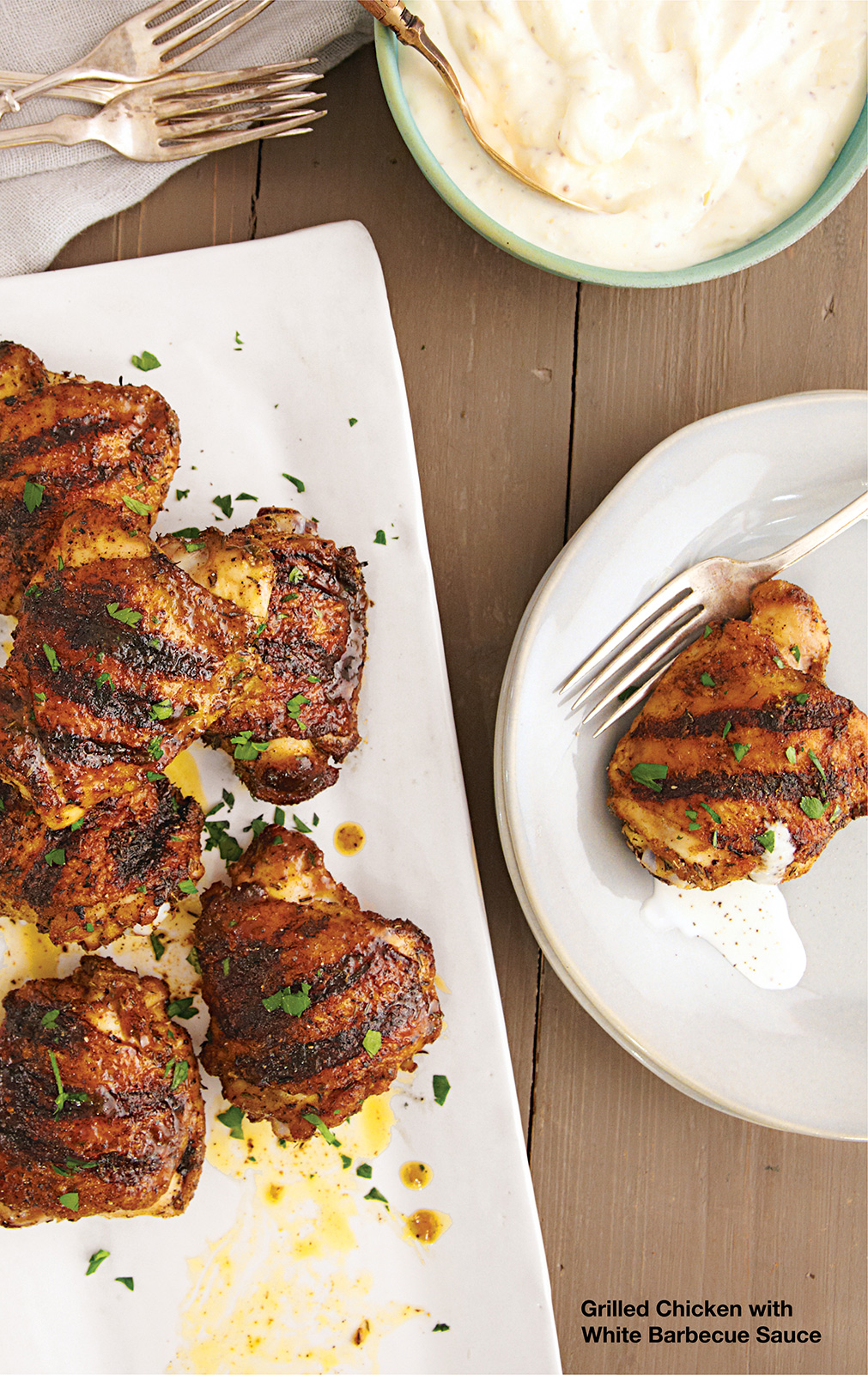

~ You've Gotta Try ~
Alabama White Barbecue Sauce
In northern Alabama they like “regular” barbecue sauce (the spicy tomato-based sort with hickory-smoked flavor) just fine. But what they’re most famous for, the thing that is uniquely theirs, is Alabama white barbecue sauce.
Don McLemore, whose grandfather opened Big Bob Gibson’s in Decatur in 1925, says his granddaddy came up with the combination of mayonnaise, fresh-cracked black pepper, fresh lemon juice, and cider vinegar. Big Bob’s has popularized it ever since.
’Cue aficionados use it specifically to douse their smoked chicken. The place to try it in Birmingham is the beloved Miss Myra’s Pit Bar-B-Q, which has the typical pig-inspired decor, devoted folks lining up at lunchtime for rib platters and the like, and bottles of both red and white sauces on the tables

Grilled Chicken with White Barbecue Sauce
Makes 5 servings Hands-On Time 20 min. Total Time 4 hours, 35 min.
1 Tbsp. dried thyme
1 Tbsp. dried oregano
1 Tbsp. ground cumin
1 Tbsp. paprika
1 tsp. onion powder
1/2 tsp. table salt
1/2 tsp. black pepper
10 chicken thighs (about 3 lb.)
1. Combine first 7 ingredients. Rinse chicken, and pat dry; rub mixture evenly over chicken. Place chicken in a zip-top plastic freezer bag. Seal and chill 4 hours. Remove chicken from bag, discarding bag.
2. Preheat grill to 350° to 400° (medium-high) heat. Grill, covered with grill lid, 8 to 10 minutes on each side or until a meat thermometer inserted into thickest portion registers 180°. Serve with White Barbecue Sauce.
Note: Four chicken leg quarters (about 3 lb.) may be substituted for chicken thighs. Increase cooking time to 20 to 25 minutes on each side.
1 1/2 cups mayonnaise
1⁄4 cup white wine vinegar
1 garlic clove, minced
1 Tbsp. coarse, ground black pepper
1 Tbsp. spicy brown mustard
1 tsp. sugar
1 tsp. table salt
2 tsp. horseradish
1. Stir together all ingredients until well blended. Refrigerate in an airtight container up to 1 week.

~ A Recipe from a Local ~
Not Yo’ Mama’s Mac ’N’ Cheese
Decadent is the only word to describe this top-rated mac ’n’ cheese from John’s City Diner in Birmingham. The smoked Gouda adds marvelous flavor, but you can substitute regular Gouda.
Makes 8 to 10 servings Hands-On Time 1 hour Total Time 1 hour, 20 min.
1 cup panko (Japanese breadcrumbs)
1 (4-oz.) package thinly sliced prosciutto
1 (16-oz.) package penne or cavatappi pasta
1/2 cup butter
1 shallot, minced
1/4 cup dry white wine
1/4 cup all-purpose flour
2 cups milk
2 cups whipping cream
1 bay leaf
1/2 tsp. table salt
1/4 tsp. ground red pepper
2 (10-oz.) blocks sharp white Cheddar cheese, shredded
1 cup (4 oz.) shredded smoked Gouda
1/2 cup (2 oz.) shredded Parmesan cheese
1. Preheat oven to 400°. Bake breadcrumbs in a single layer on a baking sheet 5 to 7 minutes or until golden, stirring once after 2 1/2 minutes.
2. Cook prosciutto, in batches, in a lightly greased large skillet over medium heat 3 to 4 minutes on each side or until crisp. Drain on paper towels; crumble.
3. Prepare pasta according to package directions.
4. Meanwhile, melt butter in a Dutch oven over medium heat; add shallot, and sauté 3 minutes or until tender. Add wine, stirring to loosen particles from bottom of Dutch oven, and cook 1 minute.
5. Gradually whisk in flour until smooth; cook, whisking constantly, 2 minutes. Gradually whisk in milk and next 4 ingredients; cook, whisking constantly, 12 to 14 minutes or until mixture thickens and begins to bubble. Remove and discard bay leaf.
6. Place 4 cups (16 oz.) Cheddar cheese in a large heatproof bowl; reserve remaining Cheddar cheese for another use. Add Gouda and Parmesan cheeses to bowl.
7. Gradually pour white sauce over cheeses, whisking until cheeses melt and sauce is smooth.
8. Stir in pasta and prosciutto until blended. Pour into a lightly greased 13- x 9-inch baking dish; sprinkle with breadcrumbs.
9. Bake at 400° for 15 minutes or until bubbly. Serve immediately.
Note: Don’t use preshredded cheese; it doesn’t melt as smoothly. You can shred the cheese and crisp the prosciutto up to 1 day ahead and chill. You can also toast the breadcrumbs ahead and store them in a zip-top plastic bag.
For No-Bake Mac ’N’ Cheese: Omit breadcrumbs. Prepare recipe as directed in Steps 2 through 6. Stir pasta, prosciutto, and cheeses into white sauce. Serve immediately.
Executive Chef Shannon Gober, John’s City Diner
Birmingham, Alabama

Fried Green Tomato Stacks
For bacon drippings, fry three to four bacon slices in a skillet until crisp; remove bacon from skillet, and reserve bacon for another use.
Makes 6 servings Hands-On Time 25 min. Total Time 1 hour, 15 min.
3 tomatillos, husked
2 Tbsp. bacon drippings
1 garlic clove, pressed
1 1/2 tsp. table salt, divided
1 tsp. black pepper, divided
1/2 tsp. paprika
1/4 cup thinly sliced fresh basil
1 1/2 cups self-rising yellow cornmeal mix
4 large green tomatoes, cut into 18 (1/4-inch) slices
1 cup buttermilk
Peanut oil
1 (8-oz.) package cream cheese, softened
1 (4-oz.) package goat cheese, softened
1/3 cup milk
1 tsp. sugar
1. Bring tomatillos and water to cover to a boil in a small saucepan; reduce heat, and simmer 10 minutes. Drain tomatillos, and cool.
2. Process tomatillos, bacon drippings, garlic, 1/2tsp. salt, 1/2 tsp. pepper, and paprika in a food processor or blender until smooth; stir in basil. Cover and chill until ready to serve.
3. Stir together cornmeal mix, 3/4 tsp. salt, and remaining 1/2 tsp. pepper. Dip tomato slices in buttermilk, shaking off excess; dredge in cornmeal mixture.
4. Pour oil to a depth of 1/2 inch in a skillet; heat to 375°. Fry tomato slices, in batches, in hot oil 1 to 2 minutes on each side; drain on a wire rack over paper towels. Keep warm.
5. Combine cream cheese, next 3 ingredients, and remaining 1/4 tsp. salt. Place 1 fried tomato slice on each of 6 salad plates; top each evenly with half of cream cheese mixture. Top each with 1 fried tomato slice and remaining cream cheese mixture. Top with remaining 6 fried tomato slices; drizzle with tomatillo dressing.
Cathedral Chicken Salad
Serve this deliciously simple recipe like they do during the Lenten lunches at Birmingham’s Cathedral Church of the Advent: on a lettuce leaf with a sprinkle of paprika.
Makes about 3 1/2 cups Hands-On Time 10 min. Total Time 10 min.
1/2 cup mayonnaise
1 Tbsp. fresh lemon juice
2 tsp. Dijon mustard
1/2 tsp. ground white pepper
1/2 tsp. seasoning salt
3 cups chopped cooked chicken
1/2 cup chopped celery
1. Stir together first 5 ingredients until blended.
2. Place chicken and celery in a large bowl; add mayonnaise mixture, and toss to combine.

Order a
“Meat-and-Three”
Like a Local
They’re either sit-down eateries or cafeteria-style setups that allow each diner to select one protein and three sides from a seemingly endless array of choices: for the meat, you can expect barbecued or fried chicken, brisket, meatloaf, or catfish; for the sides, selections often include macaroni and cheese, collard greens, squash casserole, and congealed salads, plus cornbread and sweet tea.
Take Niki’s West, a big cafeteria that has been serving Birmingham its meat-and-threes since 1957 and steers as many as 2,000 diners through its line at lunch. The pace is one reason so many folks always order the same thing. You don’t want to be still mulling the choices when you grab your tray and the kindly but superefficient folks ask: “Serve you?”

~ A Recipe from a Local ~
Summer Grilled Peach Salad
Gorgonzola cheese gets gooey and delicious when it’s melted over the grilled peaches in this amazing summer salad.
Makes 4 servings Hands-On Time 20 min. Total Time 30 min.
1 cup pecans
4 large fresh, ripe peaches, halved
3 Tbsp. extra virgin olive oil, divided
1 (4-oz.) wedge Gorgonzola cheese, broken into 8 pieces
2 cups arugula
1/4 cup honey*
2 Tbsp. finely chopped chives
1. Preheat oven to 350°. Bake pecans in a single layer in a shallow pan 10 to 12 minutes or until toasted and fragrant, stirring halfway through.
2. Preheat grill to 350° to 400° (medium-high) heat. Gently toss peach halves in 1 Tbsp. olive oil; sprinkle with salt and pepper to taste. Grill peaches, cut sides down, covered with grill lid, 2 to 3 minutes or until golden. Turn peaches, and place 1 cheese piece in center of each peach; grill, covered with grill lid, 2 to 3 minutes or until cheese begins to melt.
3. Toss arugula with remaining 2 Tbsp. olive oil and salt and pepper to taste. Arrange arugula on a serving platter; sprinkle with toasted pecans, and top with grilled peach halves. Drizzle peaches with honey, and sprinkle with chives.
Note: Aged balsamic vinegar may be substituted.
Executive Chef Haller Magee, Satterfield’s Restaurant
Birmingham, Alabama

Meet Chef
Frank Stitt
He put Birmingham on the culinary map when he opened Highlands Bar and Grill in the Five Points South neighborhood in 1982.
Stitt originally left his small northern Alabama town of Cullman to study philosophy in Berkeley, California. Instead, he fell in love with the cooking of Alice Waters at her venerable Chez Panisse restaurant and soon was off to France to devote himself to studying with the great cooking teacher and cookbook writer Richard Olney.
Eventually Stitt came home and gave Birmingham what it didn’t even know it needed: a glorious fine-dining destination, housed in a 1920s building decorated with vintage French posters. To this day, Highlands applies classic French technique to the local and coastal Alabama bounty.
Stitt owns three other nearby restaurants—the French bistro Chez Fonfon, the Italian restaurant Bottega, and the more casual Bottega Café next door.


“The delicacy of flounder fillets is complemented here by tiny, tender, pale green lady peas, which are the most delicate of the pea world. Basil, dill, and chives make this nontraditional succotash very special.” —Frank Stitt
Flounder with Lady Pea Succotash
Makes 4 servings Hands-On Time 45 min. Total Time 45 min.
SUCCOTASH
1 small red onion, cut into 1-inch-thick slices
2 ears fresh corn
1 cup cooked lady peas*, drained, plus 1⁄4 cup reserved pot liquor (cooking liquid from the peas)
2 tomatoes, seeded and cut into 1⁄4-inch dice
1/2 small shallot, finely minced
4 basil leaves, torn into pieces
1 Tbsp. chopped fresh dill weed
1 Tbsp. finely chopped fresh chives
3 Tbsp. extra virgin olive oil
1 Tbsp. sherry vinegar
FLOUNDER
4 (6- to-8 oz.) flounder fillets, skin on or skinless
1/2 tsp. kosher salt
1/4 tsp. freshly ground black pepper
5 tsp. vegetable oil
1 lemon, cut into wedges
Extra virgin olive oil (optional)
1. Prepare the Succotash: Preheat grill to 350° to 400° (medium-high) heat or preheat broiler with oven rack 5 1/2 inches from heat. Grill onion slices, covered with grill lid, or broil onion slices 4 minutes on each side or until lightly charred. Cool slightly, and cut into 1/4-inch dice. Cook corn in boiling water to cover 4 minutes; drain. Cut kernels from cobs; discard cobs. Combine charred onion, corn, peas, tomatoes, shallot, basil, dill, and chives in a large bowl. Stir in 3 Tbsp. olive oil, sherry vinegar, and reserved pot liquor. Add kosher salt and freshly ground white pepper to taste.
2. Prepare the Flounder: Season the fish with salt and pepper. Heat 3 tsp. oil in a large heavy skillet over medium-high heat until shimmering. Reduce heat to medium, place 2 fillets (skin side up, if they have skin) in the skillet, and cook 3 minutes on each side or until golden brown and fish flakes with a fork. (Peek inside one fillet to check for doneness—the thickest part should have turned pearly white.) Remove fish from skillet; keep warm. Heat remaining 2 tsp. oil in skillet, and repeat procedure with remaining fillets. Place succotash in a large sauté pan, and cook over medium heat 2 minutes or until heated through. Transfer fish to plates, and serve with succotash and lemon wedges. Drizzle each fillet with olive oil, if desired.
Note: If lady peas are not available, substitute pink-eyes, white acres, crowders, cranberry beans, fresh fava beans, or sweet peas.

Meet Country Singer
Sara Evans
She started playing professionally only to help pay the bills after a car accident left her with two broken legs.
It was soon apparent that her music could do more than earn her a little extra cash, and Evans moved from Missouri to Nashville to try her luck singing in nightclubs.
She signed a contract with RCA, which released her first album, Three Chords and the Truth, in 1997. Her next record, No Place That Far, took off, thanks in part to a chart-topping duet with Vince Gill. More hits followed, including Restless in 2003, Real Fine Place in 2005, and Stronger in 2011.
Today, Evans makes her home in Birmingham with husband, Jay Barker, a former University of Alabama quarterback and current football commentator, and enjoys cooking for their combined seven kids and sharing recipes.


“It’s not hard to cook for your family. I think people are intimidated by it. It’s not about making gourmet meals but about sitting down as a family and having that meal together. There’s something important about that.” —Sara Evans
Cheesy Potato Soup
Makes 8 servings Hands-On Time 20 min. Total Time 40 min.
3 lb. baking potatoes (6 to 8 medium)
1 small white onion, finely chopped
4 cups milk or half-and-half
1 (10 3/4-oz.) can cream of mushroom, chicken, or potato soup
1 (8-oz.) package processed cheese (such as Velveeta), cubed
Round buttery crackers or saltine crackers, crushed
1/4 cup (1 oz.) shredded sharp Cheddar cheese
1. Peel potatoes, and cut into bite-size pieces. Boil potatoes and onion together in a 6-qt. Dutch oven of salted water (1 tsp. salt to 12 cups water) 15 to 20 minutes or until tender. Drain potato mixture in a fine wire-mesh strainer, and return to pot.
2. Add milk, can of soup, and cheese to potato mixture; bring to a simmer over medium heat, and cook, stirring occasionally, 4 minutes or until cheese melts. Add salt and pepper to taste.
3. Divide among serving bowls. Top with crushed crackers and Cheddar cheese.
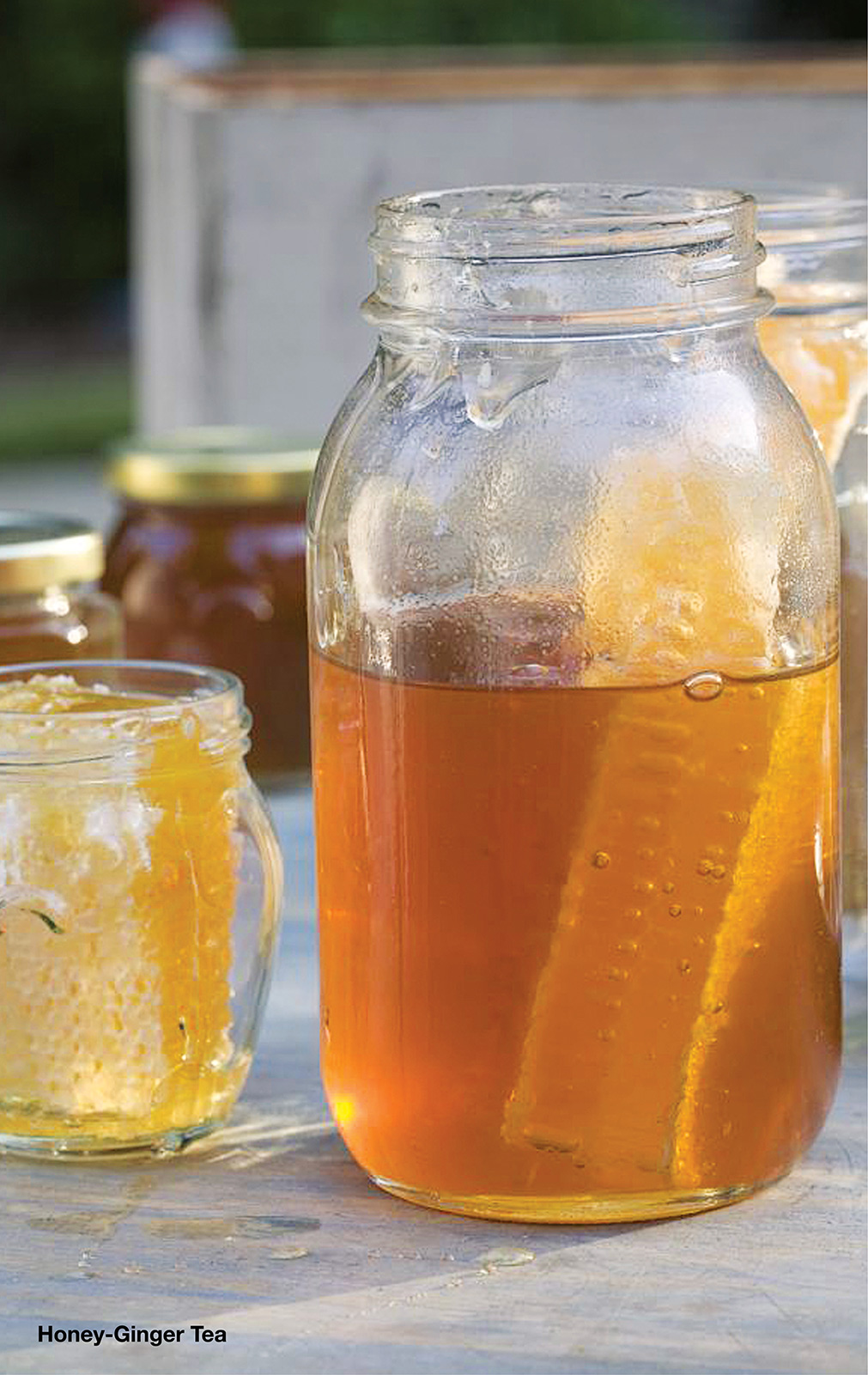
~ A Recipe from a Local ~
Honey-Ginger Tea
This hot tea has Southern personality: sweet as honey with a peppery kick.
Makes 1 cup Hands-On Time 5 min. Total Time 10 min.
1 (1-inch) piece fresh ginger, peeled
1 regular-size green tea bag
1 Tbsp. fresh lemon juice
2 Tbsp. honey
1 cup boiling water
1. Grate ginger, using the large holes of a box grater, to equal 1 Tbsp. Squeeze juice from ginger into a teacup; discard solids. Place tea bag, lemon juice, and honey in teacup; add boiling water. Cover and steep 3 minutes. Remove and discard tea bag, squeezing gently.
Rose Marie Crowe
Trussville, Alabama
~ A Recipe from a Local ~
Vanilla-Rosemary Lemonade
Fresh herbs add verve to freshly squeezed lemon juice in this aromatic drink.
Makes 6 cups Hands-On Time 30 min. Total Time 4 hours
1 1/2 cups sugar
1 vanilla bean, split
3 small fresh rosemary sprigs
3 cups fresh lemon juice (26 to 30 lemons)*
1. Combine sugar, vanilla bean, rosemary, and 3 cups water in a medium saucepan. Bring to a light boil over medium heat, stirring occasionally. Simmer 5 minutes. Remove from heat, and cool 30 minutes.
2. Pour through a fine wire-mesh strainer into a large pitcher, discarding solids. Stir in fresh lemon juice. Cover and chill 3 to 48 hours. Stir just before serving over ice.
Note: Three (7.5-oz.) containers frozen lemon juice, thawed, may be substituted.
Maureen Holt, Little Savannah Restaurant
Birmingham, Alabama

Visit the
Moto-Museum
Like a Local
Its holdings include 84 Harley-Davidsons and 21 of the bikes the Guggenheim Museum borrowed for its historic “Art of the Motorcycle” exhibit in 1998.
After a tour, go to the adjacent Barber Motorsports Park for a chance to see the machines roar. Every October, the park hosts the Barber Vintage Festival, an event featuring antique motorcycle road racing plus motocross, cross-country events, an airshow, and a “swap meet” with 250 vendors.
Barber also has a very popular Indy car race series and Grand-Am racing, which includes Grand Touring class cars, muscle cars and BMWs—not to mention Porsches, the favorite of owner George Barber.
A Birmingham dairy and real estate magnate, and, most pertinently, a former driver for the Sports Club of America—Barber parlayed his passion for vintage cars (and later motorcycles) into this terrific museum and park.


Though he was born in New Albany, Mississippi, in 1897, Faulkner moved with his family to Oxford shortly before his fifth birthday and lived there off and on, when he wasn’t traveling or on loan to a university’s literature department, for the rest of his life. He attended the University of Mississippi, albeit briefly; famously, he earned a D in English and dropped out. He based many of the characters in his fictional Yoknapatawpha County around ones he knew in and around Lafayette County, of which Oxford is the county seat.
By 1930, he’d written The Sound and the Fury and As I Lay Dying and achieved enough success to buy an antebellum Oxford home, which he named Rowan Oak and owned until his death in 1962. Faulkner won the 1949 Nobel Prize for Literature, and two of his lesser-known novels won Pulitzer Prizes in 1955 and 1963. Rowan Oak was sold by Faulkner’s estate to the university in 1972 and is meticulously maintained as a museum—complete with his old typewriter in his office and mud-caked boots at his doorway. This literary landmark is open for tours most Tuesdays through Sundays.
Many other beloved writers have taken up residence in and around Oxford: Eudora Welty, Tennessee Williams, Richard Ford, Shelby Foote, Willie Morris, Barry Hannah, Walker Percy, Larry Brown, Donna Tartt, and John Grisham. First editions of the works of lots of these folks can be found in another Oxford landmark: Square Books, so named because it’s on the town square. Open since 1979, it’s routinely listed among the country’s top independent booksellers
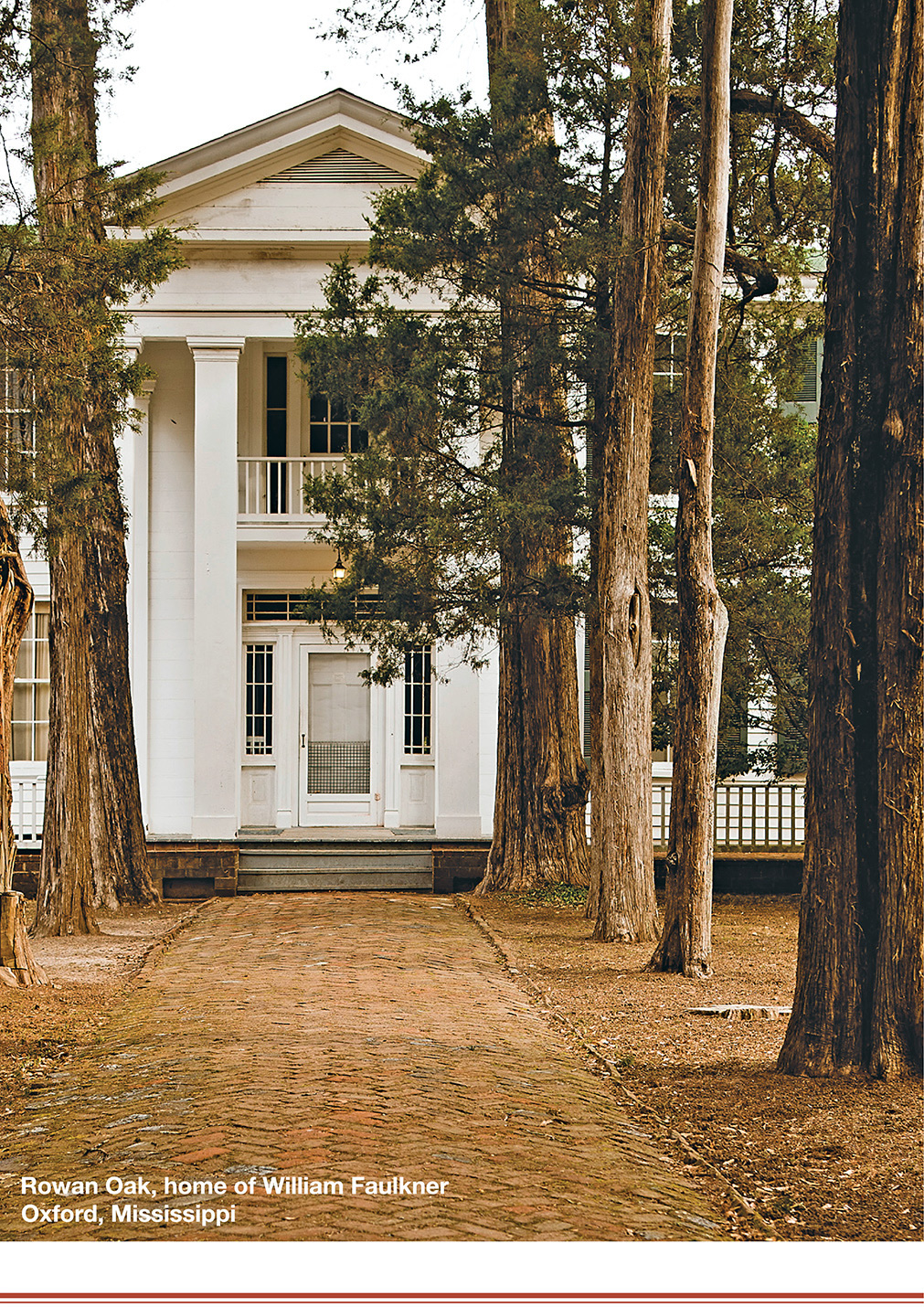

Honeysuckle-Watermelon Cocktails
Makes 8 cups Hands-On Time 20 min. Total Time: 20 min.
8 cups seeded and cubed watermelon (about 1 [6-lb.] watermelon)
1 cup honeysuckle vodka*
1/2 cup fresh lime juice
1/4 cup sugar
4 cups ice cubes
2 cups lemon-lime soft drink
Garnishes: lime slices, diced watermelon, fresh mint leaves
1. Process watermelon in a blender or food processor until smooth. Pour through a fine wire-mesh strainer into a large pitcher, using back of a spoon to squeeze out juice; discard solids.
2. Stir vodka and next 2 ingredients into watermelon juice. Add ice, and top with soft drink; gently stir. Serve immediately.
Note: We tested with Mississippi’s Cathead Honeysuckle Flavored Vodka. Light rum or plain vodka may by substituted.
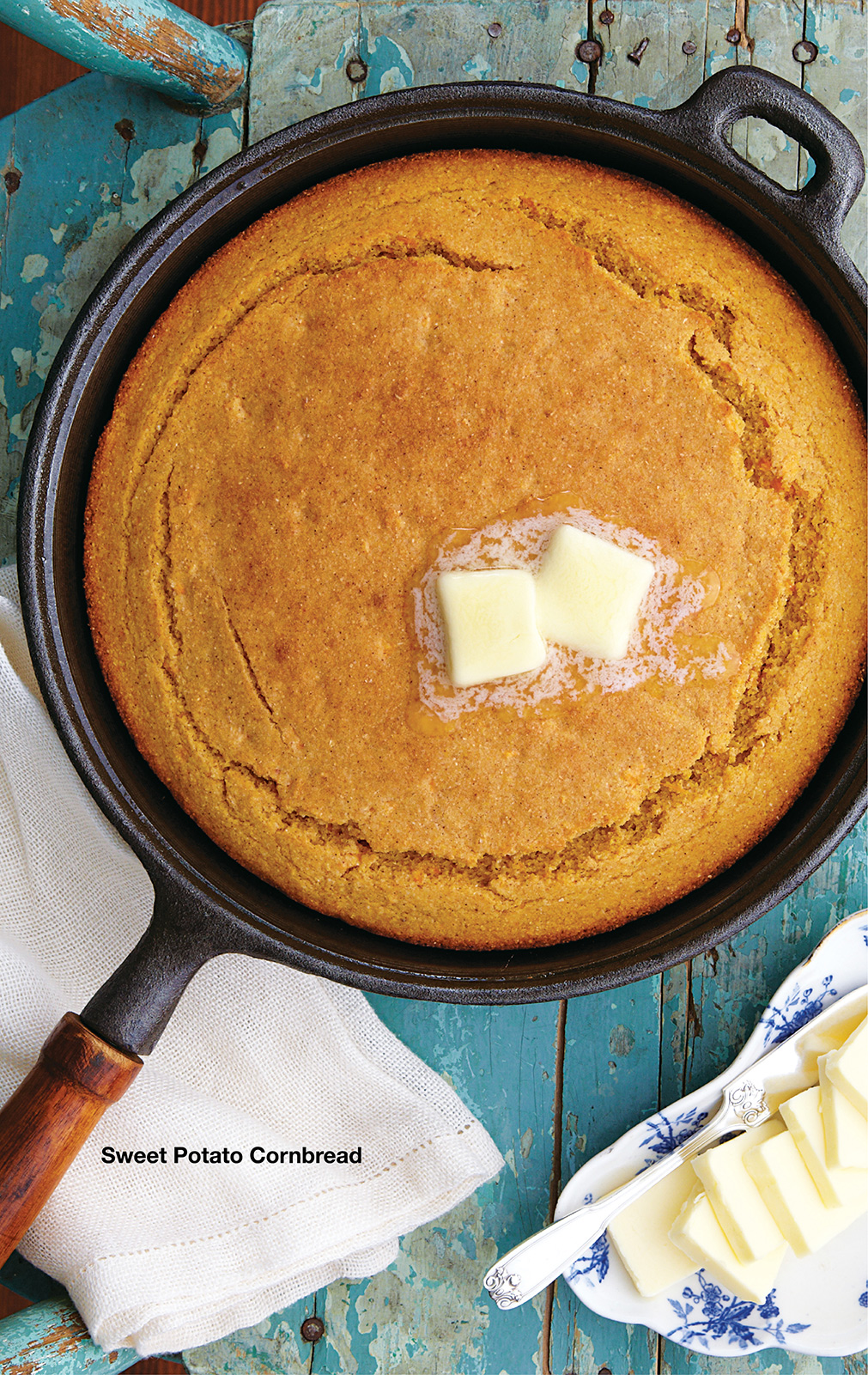
Sweet Potato Cornbread
The potatoes add a touch of sweetness and a lush texture to this beloved Southern bread. Use it as the base for a barbecue sandwich, or serve it in place of regular cornbread alongside your favorite meal.
Makes 6 servings Hands-On Time 15 min. Total Time 50 min.
2 cups self-rising white cornmeal mix
3 Tbsp. sugar
1/4 tsp. pumpkin pie spice
5 large eggs
2 cups mashed cooked sweet potatoes (about 1 1/2 lb. sweet potatoes)
1 (8-oz.) container sour cream
1/2 cup butter, melted
1. Preheat oven to 425°. Heat a 10-inch cast-iron skillet in oven 5 minutes. Meanwhile, stir together first 3 ingredients in a large bowl; make a well in center of mixture. Whisk together eggs and next 3 ingredients; add to cornmeal mixture, stirring just until moistened. Spoon batter into hot, lightly greased skillet.
2. Bake at 425° for 35 minutes or until golden brown.

~ A Recipe from a Local ~
Delta-Style Fried Catfish
Serve with fries and coleslaw, and put out a bottle of hot sauce for extra spice.
Makes 6 servings Hands-On Time 25 min. Total Time 8 hours, 35 min.
1 1/2 cups milk
2 to 3 drops hot sauce
6 (4- to 6-oz.) catfish fillets
3/4 cup yellow cornmeal
1/4 cup all-purpose flour
2 tsp. table salt
1 tsp. ground black pepper
1 tsp. ground red pepper
1/4 tsp. garlic powder
Vegetable oil
1. Whisk together milk and hot sauce. Place catfish fillets in a single layer in a 13- x 9-inch baking dish; cover with milk mixture. Cover and chill 8 hours, turning once. Combine cornmeal and next 5 ingredients in a shallow dish, and set aside.
2. Let catfish fillets stand at room temperature in milk mixture in baking dish 10 minutes. Remove fillets from milk mixture, allowing excess to drip off. Dredge catfish fillets in cornmeal mixture, shaking off excess.
3. Pour oil to a depth of 1 1/2 inches into a large, deep cast-iron or heavy-duty skillet; heat to 360°. Fry fillets, in batches, 2 minutes on each side or until golden brown. Remove to a wire rack on a paper towel-lined jelly-roll pan. Keep warm in a 225° oven until ready to serve.
Jack Perkins
Isola, Mississippi

Appreciate
the Blues
Like a Local
First stop: the third floor of the J.D. Williams Library on the Ole Miss campus, which houses an unparalleled blues archive including more than 60,000 audio recordings, vintage memorabilia, photographs, periodicals, and B.B. King’s personal record collection.
Next: Hear some music. Great places to do it include Proud Larry’s, a quirky and tasty pizza joint, where you might hear acts like the North Mississippi Allstars or artists on the local Oxford blues label Fat Possum Records.
If you’re feeling ambitious, take Highway 61 west for about an hour and visit the Ground Zero Blues Club in Clarksdale. Dedicated to preserving the authentic Delta blues experience, it’s co-owned by actor Morgan Freeman, who’s often in the audience.
Complete your Oxford blues immersion by spending a night at The 5 Twelve, a charming six-room bed-and-breakfast in a century-old home co-owned by George McConnell, a former guitarist for the jam band Widespread Panic.


Meet Journalist
John T. Edge
He directs the Southern Foodways Alliance, a part of the Center for the Study of Southern Culture at the University of Mississippi in Oxford, and also writes cookbooks and columns on Southern food and culture for The New York Times.
He’s an old-school journalist who writes in an informed yet still curious way about the subjects that are most important to him: the sanctity of fried chicken, the exciting trendiness of the Mexican torta sandwich, and the “polyglot puree” that is Asian Sriracha hot chili sauce.
“The rest of the country is finally recognizing what we already know,” Edge has written in Garden & Gun. “Southern food is America’s most vital and vibrant.”

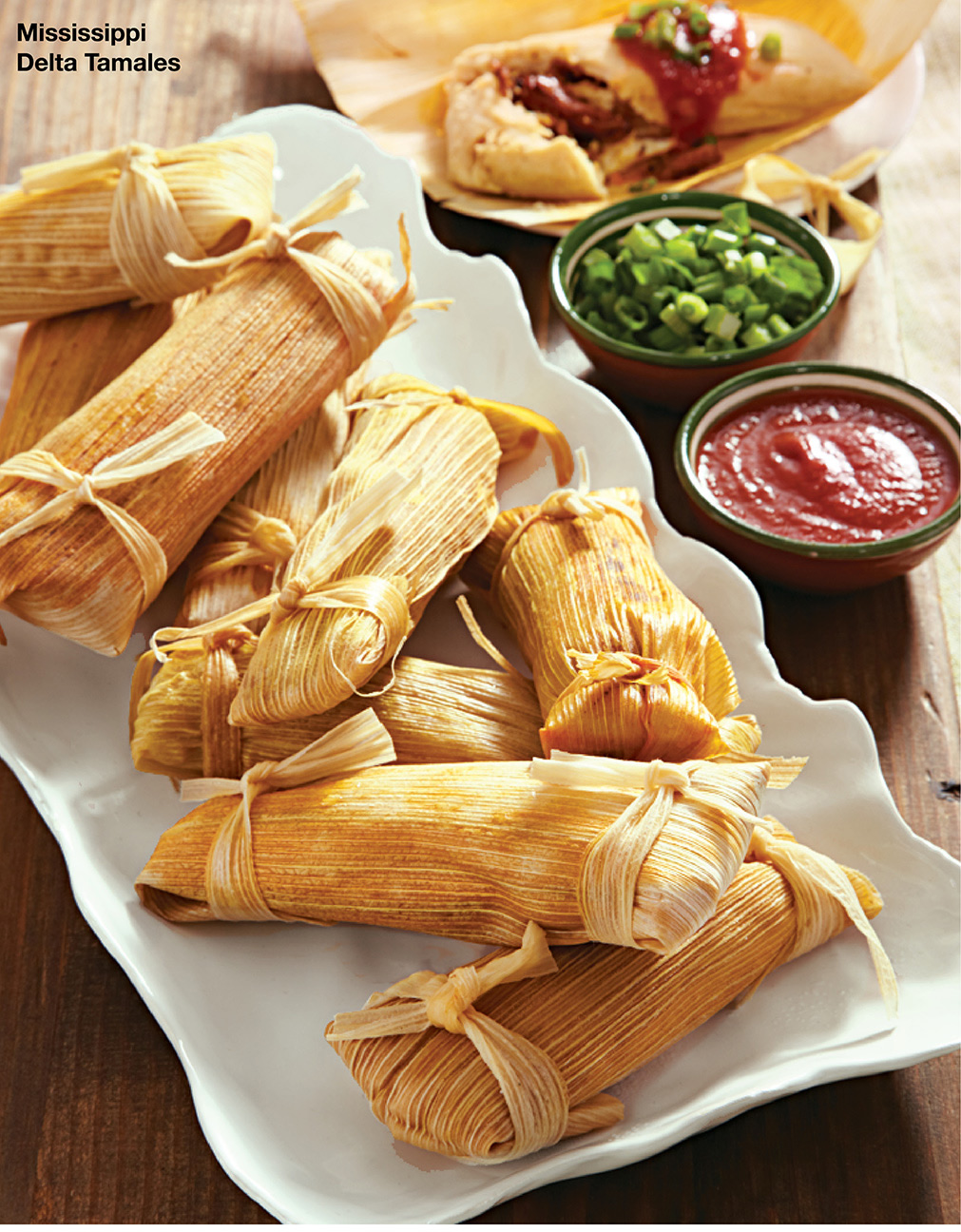
“Instead of stuffing the tamales with a salsa or mole-stewed meat, these are filled with a mix that’s very similar to chili, giving them a flavor profile far more at home at a fried chicken joint than a taqueria.” —John T. Edge
Mississippi Delta Tamales
There are many takes on how tamales entered the Southern food canon, but they all have something to do with Mexican laborers migrating north and east from Texas to pick cotton. When they shared their corn husk-wrapped snacks with African-American laborers, the tradition of the Mississippi Delta tamale was born. For more information, check out the Southern Foodways Alliance’s Tamale Trail documentary project at www.tamaletrail.com.
Makes about 5 dozen Hands-On Time 2 hours, 3 min. Total Time 5 hours, 33 min.
OTHER
1 (6-oz.) package dried corn husks
FILLING
1 (3-lb.) boneless pork shoulder roast (Boston butt)
1/2 cup vegetable oil
1 Tbsp. table salt
3 Tbsp. chili powder
1 Tbsp. paprika
2 tsp. onion powder
2 tsp. garlic powder
1 1/2 tsp. black pepper
1 tsp. ground red pepper
1 tsp. ground cumin
MASA DOUGH
8 cups masa harina (corn flour)
4 tsp. baking powder
2 tsp. salt
1 2/3 cups lard (11 oz.)
TOPPINGS (optional)
Chopped green onion
1. Soak corn husks in a large bowl or sink of very warm water until they are softened and pliable, about 2 hours.
2. Meanwhile, prepare the Filling: Cut the pork into large chunks, and place in a large, heavy pot. Cover with cold water. Bring to a boil over high heat. Cover the pot, reduce the heat to medium-low, and simmer until the meat is very tender, 2 hours. Remove the meat, and set aside to cool (30 minutes). Reserve 7 cups of the cooking liquid.
3. Gently separate the softened husks into single leaves, trying not to tear them. Wash off any dust, and discard any corn silks. Transfer husks to a bowl or basin of clean water, keeping aside any split husks, since two small pieces can be overlapped and used as one.
4. When the meat is cool enough to handle, remove and discard any skin and large chunks of fat. Shred the meat into small pieces. (You should have 5 cups of meat.) Heat the vegetable oil in a large, heavy skillet over medium heat. Stir in the salt and next 7 ingredients (through cumin); cook 1 minute. Add the meat, and stir to coat with the oil and spices. Cook, stirring often, until the meat is warmed through, 5 minutes. Set aside.
5. Prepare the Masa Dough: Stir the masa, baking powder, and salt in a very large bowl; cut in lard with fingers or a pastry blender until well blended. Gradually stir in reserved 7 cups meat cooking liquid to make a soft, spongy dough the consistency of thick mashed potatoes. (The dough should be quite moist, but not wet.) Cover the bowl with a damp cloth.
6. To assemble the tamales, remove a husk from the water, and pat it dry. Lay the husk on a work surface. Spread about 1/4 cup of the masa dough in an even layer lengthwise down the husk to within 1 inch of the edges. Spoon about 1 Tbsp. of the meat mixture in a line down the center of the dough. Roll the husk so that the dough surrounds the filling and forms a cylinder or package. Fold one edge under to close the bottom; leave the other end open. Place the completed tamales, with the folded edge down, in a single layer on a baking sheet. Repeat until all dough and filling are used.
7. Place a 12-inch-wide stockpot or Dutch oven on its side and carefully stack the tamales inside, folded edge touching the bottom of the pot and open end facing up. When all the tamales are comfortably packed inside, turn the pot upright. (This way, they will not fall over or come unrolled.) Add water to come almost to the top of the tamales, being careful not to pour water directly into the open ends. Bring to a boil over high heat. Cover the pot, reduce the heat to medium-low and simmer until the dough pulls away from the husk easily and cleanly, about 45 minutes.
8. Serve tamales warm, in their husks. Remove husks to eat. Top with Tamale Sauce and chopped onion, if desired.
2 (15-oz.) cans tomato sauce
2 tsp. ground chili powder
2 tsp. ground cumin
1. Stir together all ingredients in a saucepan, and bring to a boil. Reduce heat, and simmer 10 minutes, stirring occasionally, or until thickened slightly.
Note: Cooked tamales may be frozen in their husks in zip-top plastic freezer bags up to 1 month. To use, thaw overnight in refrigerator; microwave thawed tamales in a single layer, covered, at HIGH in 45-second intervals until hot.
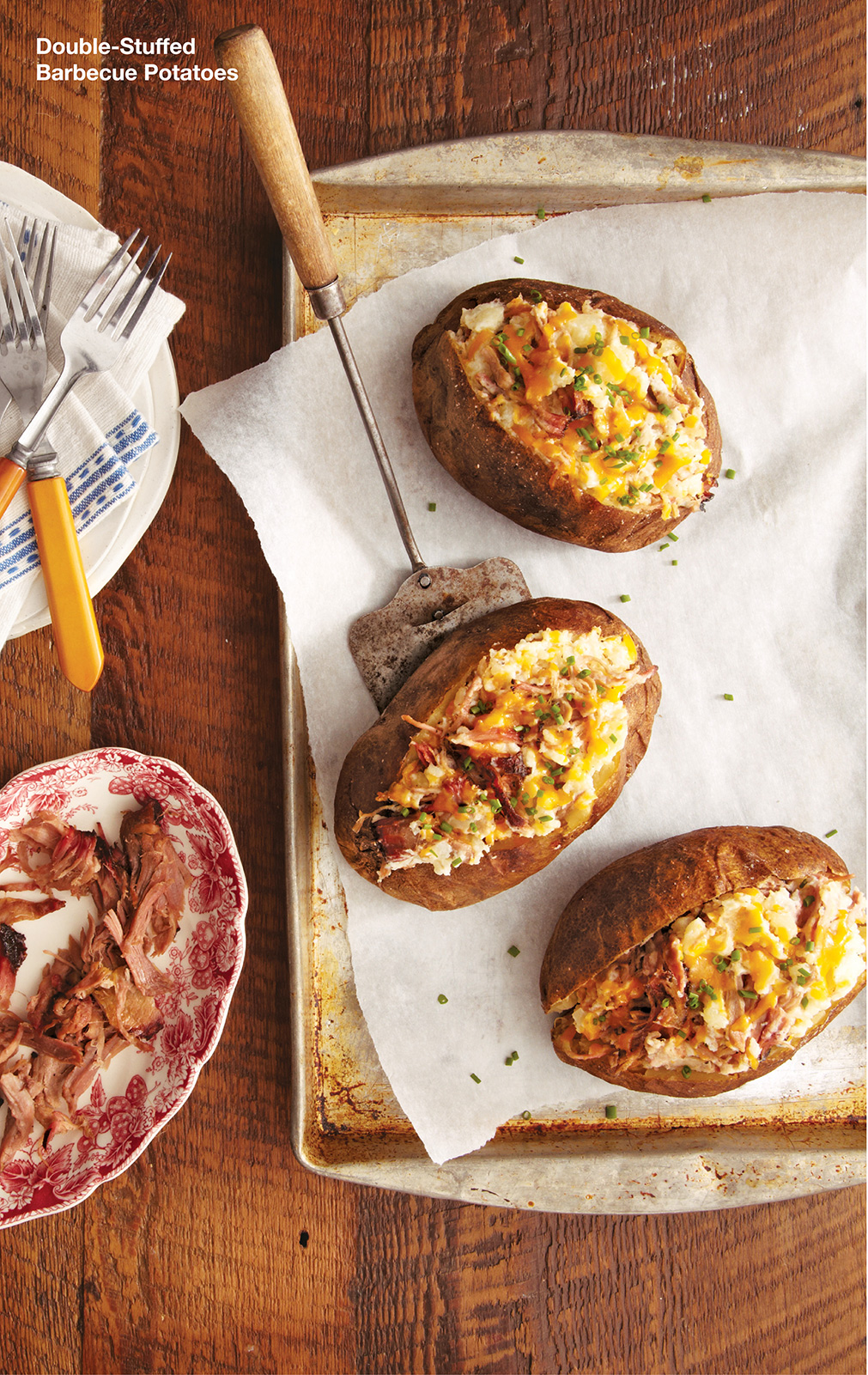
~ A Recipe from a Local ~
Double-Stuffed Barbecue Potatoes
What’s better than a stuffed baked potato? One that’s additionally stuffed with barbecued pork. You’ll find versions of it at barbecue restaurants all over Dixie.
Makes 8 servings Hands-On Time 30 min. Total Time 1 hour, 10 min.
8 large baking potatoes
1 (8-oz.) container cream cheese, softened
1/2 cup mayonnaise
1 Tbsp. white wine vinegar
1 tsp. seasoned pepper
2 tsp. fresh lemon juice
3/4 tsp. table salt
3 cups chopped barbecued pork, warmed
1 cup (4 oz.) shredded Cheddar cheese
1/4 cup chopped fresh chives
1. Preheat oven to 425°. Wrap each potato in a piece of aluminum foil; place potatoes on a baking sheet. Bake potatoes at 425° for 45 minutes or until tender. Reduce oven temperature to 375°.
2. Cut a 4- x 2-inch strip from top of each baked potato. Carefully scoop out pulp into a large bowl, leaving 8 shells intact; set aside about 2 cups of pulp for another use.
3. Mash together remaining potato pulp, cream cheese, and next 5 ingredients; stir in 2 cups of the pork. Spoon mixture evenly into shells; top evenly with remaining 1 cup of pork, Cheddar cheese, and chives. Place on a lightly greased baking sheet.
4. Bake at 375° for 20 to 25 minutes or until thoroughly heated.
Carolyn Walthall
Oxford, Mississippi
~ A Recipe from a Local ~
Mississippi Bourbon Punch
Makes about 14 cups Hands-On Time 10 min. Total Time 10 min.
2 (750-milliliter) bottles dry muscadine wine, chilled
1 (12-oz.) bottle grenadine, chilled
1 1/2 cups chilled bourbon
1 cup chilled fresh orange juice
1 cup chilled cranberry juice
1/3 cup fresh lime juice
8 cups ice cubes
1 (12-oz.) can lemon-lime soft drink, chilled
1 cup chilled club soda
1. Pour muscadine wine, grenadine, bourbon, orange juice, cranberry juice, and lime juice into a punch bowl. Stir in ice cubes, lemon-lime soft drink, and club soda.
Note: We tested with Morgan Creek Vineyards Cahaba White Alabama muscadine wine and Stirrings Authentic Grenadine. Chardonnay may be substituted.
Bartender Jayce McConnell, Snackbar
Oxford, Mississippi
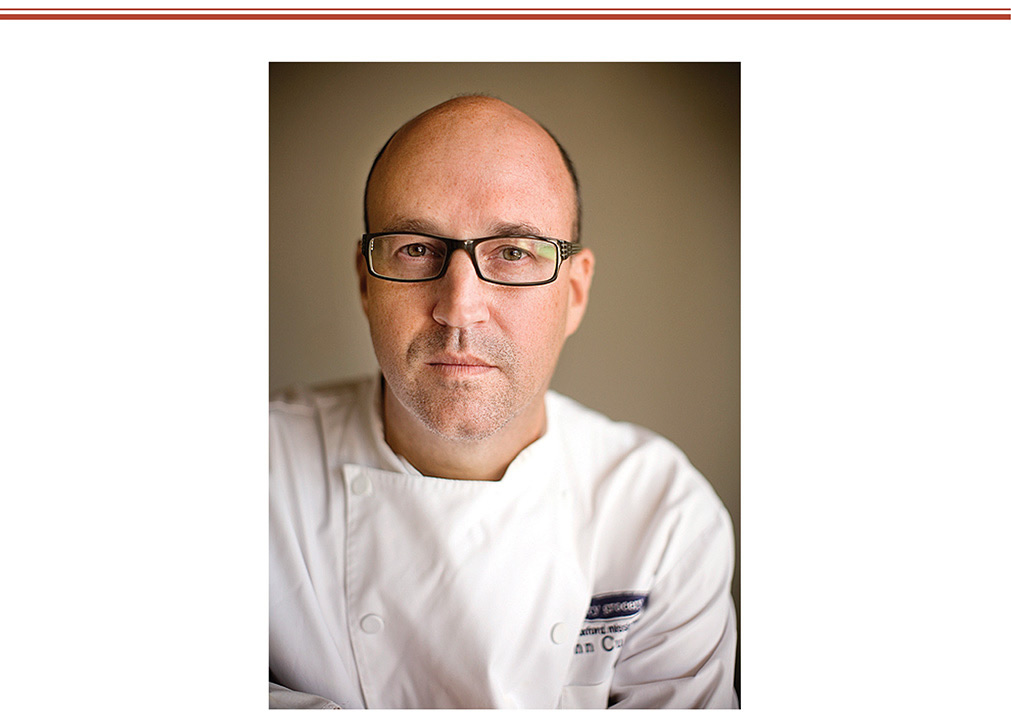
Meet Chef
John Currence
Currence arrived in Oxford after working for the famed Brennan family (of New Orleans) and, before that, at Crook’s Corner—the Chapel Hill restaurant where he first experimented with fusing French cooking techniques and Southern flavors.
Enmeshed in the local, his City Grocery menu offers the homey pleasures of Mississippi’s finest ingredients—game birds, pork, grits, Delta catfish, oysters, and the like.
Upstairs at the City Grocery bar, you’re likely to find a member of Oxford’s rich literary scene having a drink. Currence based the name of another of his Oxford restaurants, Big Bad Breakfast, upon the Larry Brown short story collection Big Bad Love. His City Grocery Restaurant Group also includes Bouré and Snackbar.

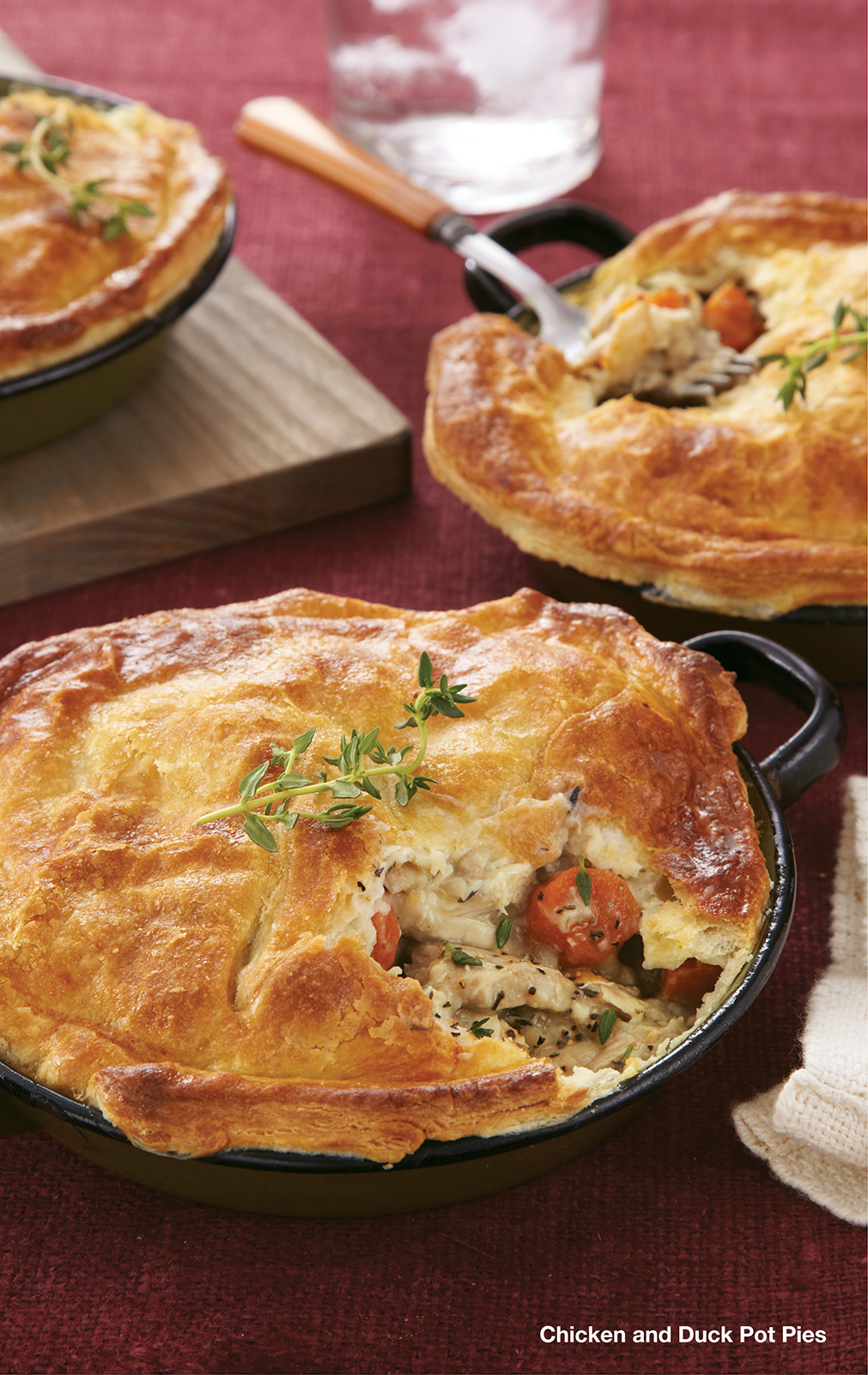
“I grew up with an unholy love for freezer-section chicken pot pie, so it only made sense to gravitate toward a tweaked-up version. I keep a stash of these around in the winter months. They are my favorite after-work meal.” —John Currence
Chicken and Duck Pot Pies
Rich duck, good mushrooms, fresh thyme, and potatoes cooked in duck fat add depth in Currence’s version of a favorite Southern comfort food.
Makes 4 (2-cup) pies Hands-On Time 1 hour, 20 min. Total Time 2 hours, 40 min.
4 carrots, cut into 1/2-inch pieces
2 medium onions, chopped
8 oz. assorted mushrooms, such as cremini and stemmed shiitake, sliced 1/2 inch thick
1 Tbsp. fresh thyme leaves
2 Tbsp. olive oil
6 garlic cloves, thinly sliced
1 (3 1/2-lb.) whole chicken
2 tsp. table salt, divided
1 1/2 tsp. freshly ground black pepper, divided
4 (6-oz.) boned duck breast halves with skin
8 oz. small red potatoes, coarsely chopped
3 cups reduced-sodium fat-free chicken broth, divided
3 Tbsp. unsalted butter
6 Tbsp. all-purpose flour
1 package frozen puff pastry, thawed
1 large egg, lightly beaten
1. Preheat oven to 400°. In a large roasting pan, toss together first 6 ingredients; spread the vegetables in an even layer. Season the chicken inside and out with 1 1/2 tsp. salt and 1 tsp. pepper. Place the chicken, breast side up, on top of the vegetables. Bake at 400° for 55 to 60 minutes or until the chicken is cooked through and the vegetables are tender. Increase oven temperature to 450°.
2. Meanwhile, make 1/4-inch-deep cuts in duck skin with a sharp knife; pat dry. Season duck with remaining 1/2 tsp. salt and 1/2 tsp. pepper. Heat a large skillet over medium-high heat; add duck, skin side down, and cook 5 minutes or until skin is well seared and fat is rendered. Turn breast halves over, and cook 7 minutes or until duck is just cooked through. Remove duck, reserving drippings in skillet. Add potatoes to hot duck drippings in skillet, and sauté 6 to 7 minutes or until tender and browned. Remove from heat. Spoon potatoes into a large bowl using a slotted spoon; reserve duck drippings in skillet.
3. Remove chicken from roasting pan; place on a platter. Add 1 cup chicken broth to roasting pan, stirring to loosen browned bits from bottom of pan. Pour chicken broth and vegetables out of roasting pan through a fine wire-mesh strainer, reserving broth in a bowl. Add drained vegetables to potatoes. Add remaining 2 cups chicken broth to reserved broth in bowl to measure 3 cups.
4. Discard skin from the chicken and duck; remove the meat from chicken, and shred. Coarsely chop duck. Add chicken and duck to potatoes and vegetables. Melt butter in skillet with reserved duck drippings over medium-high heat. Add flour, and cook 2 minutes, whisking constantly. Add reserved broth; cook, stirring often, 10 minutes or until thickened. Stir in meat and vegetables.
5. Spoon mixture into 4 (2-cup) ramekins or baking dishes. Roll puff pastry to 1/8-inch thickness on a lightly floured surface; cut into 4 circles using a 6-inch round cutter. Place 1 circle of pastry on top of each ramekin, pressing to seal. Brush with beaten egg. Place ramekins on an aluminum foil-lined jelly-roll pan; bake at 450° for 20 minutes or until pastry is browned.
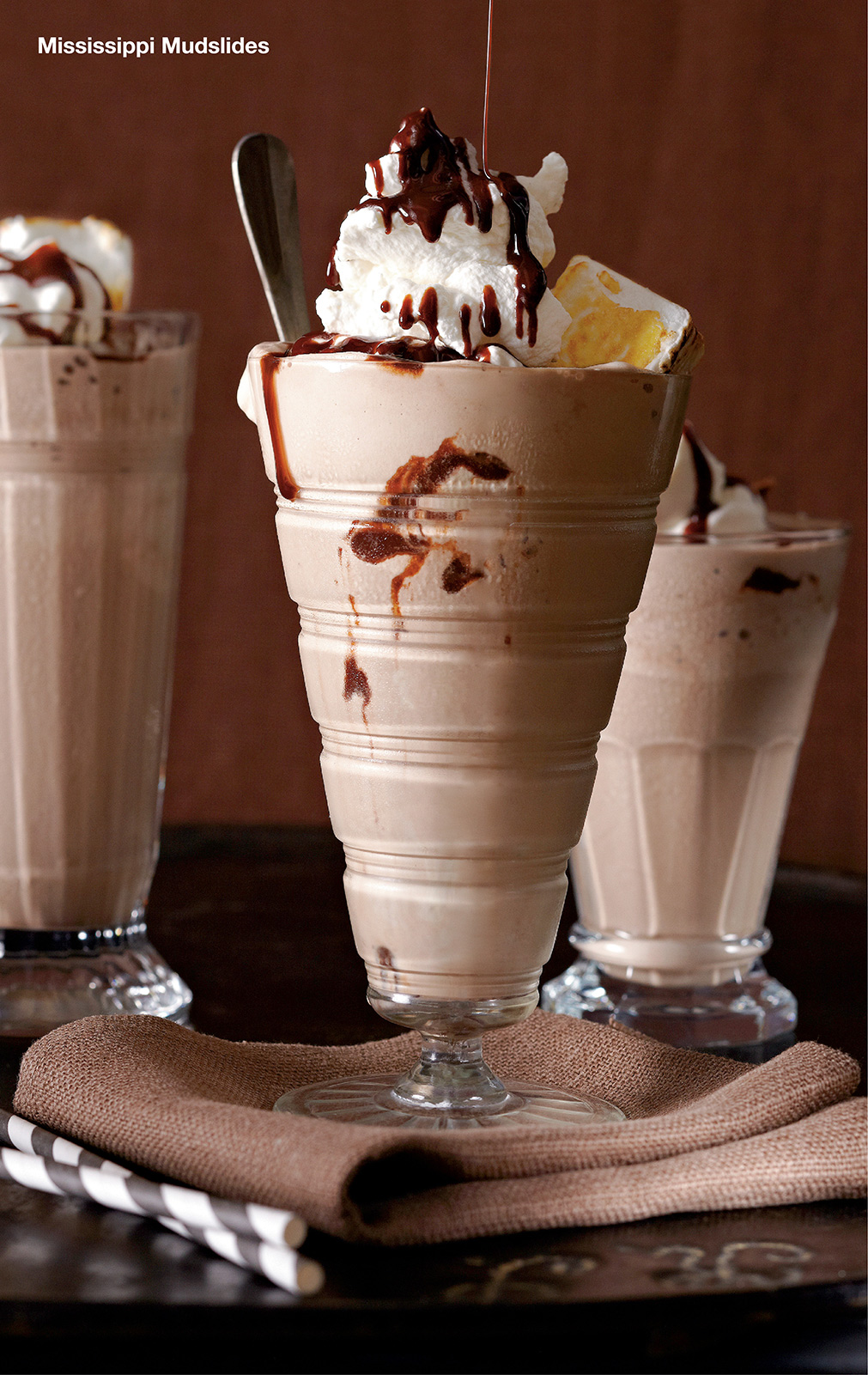
Mississippi Mudslides
Makes about 4 cups Hands-On Time 10 min. Total Time 10 min.
1 pt. chocolate ice cream
1 pt. coffee ice cream
1 cup milk
1/2 cup bourbon
Toppings: whipped cream, chocolate syrup, marshmallows
1. Process first 4 ingredients in a blender until smooth. Serve with desired toppings.
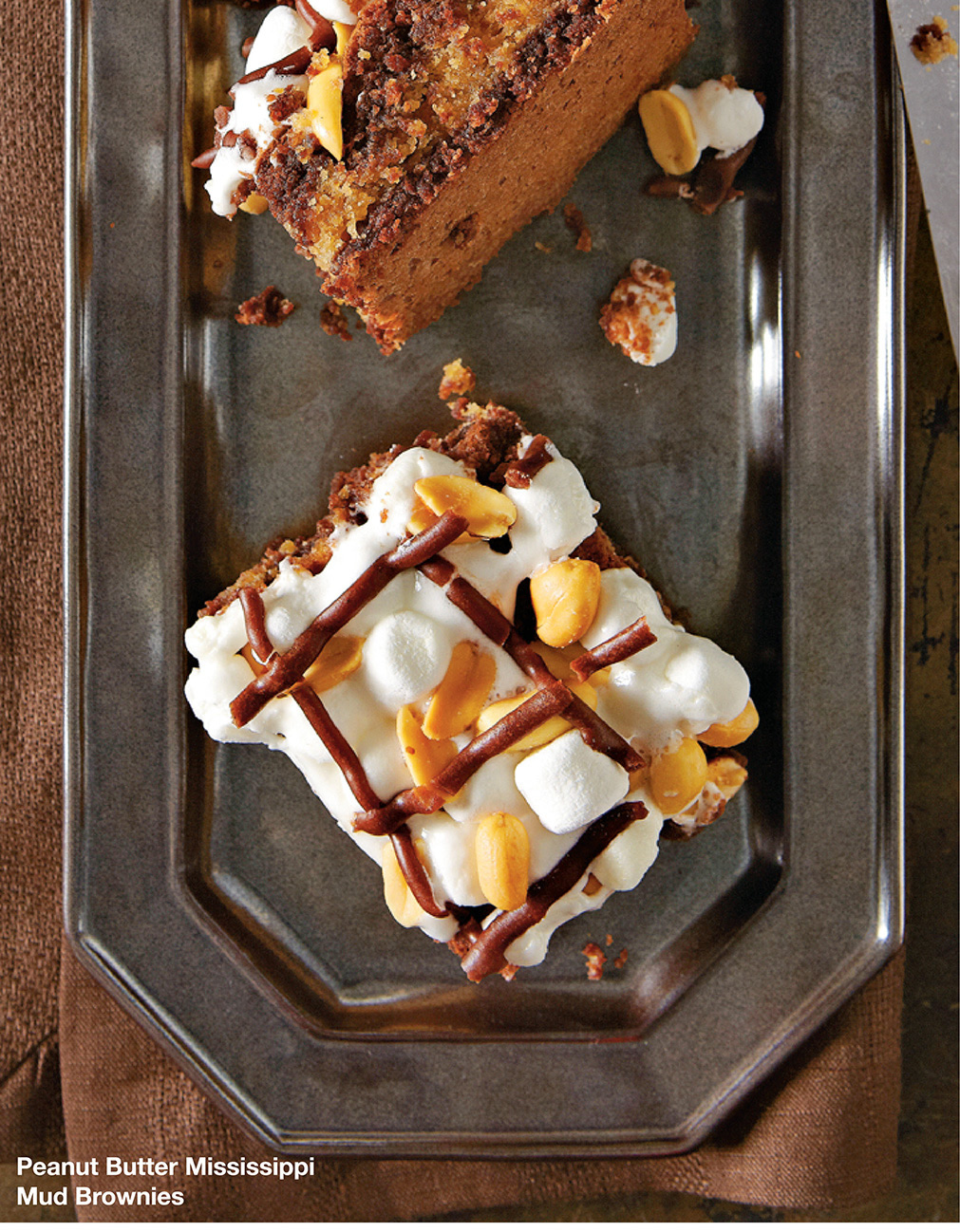
Peanut Butter Mississippi Mud Brownies
Makes about 2 1/2 dozen Hands-On Time 20 min. Total Time 1 hour, 15 min.
4 (1-oz.) unsweetened chocolate baking squares
1 1/3 cups butter, softened and divided
2 1/2 cups granulated sugar, divided
4 large eggs
2 cups all-purpose flour, divided
1 tsp. vanilla extract
1/2 cup creamy peanut butter
1/2 cup firmly packed light brown sugar
2 large eggs
1 tsp. baking powder
3 cups miniature marshmallows
1 1/2 cups lightly salted roasted peanuts
1. Preheat oven to 350°. Microwave chocolate in a microwave-safe bowl at MEDIUM (50% power) 1 1/2 minutes or until melted and smooth, stirring at 30-second intervals.
2. Beat 1 cup butter and 2 cups granulated sugar at medium speed with an electric mixer until light and fluffy. Add 4 eggs, 1 at a time, beating just until blended after each addition. Add melted chocolate, beating just until blended. Add 1 cup flour, beating at low speed just until blended. Stir in vanilla. Spread half of batter in a greased and floured 13- x 9-inch pan.
3. Beat peanut butter, brown sugar, and remaining 1/3 cup butter and 1/2 cup granulated sugar at medium speed with an electric mixer until light and fluffy. Add 2 eggs, 1 at a time, beating just until blended after each addition. Stir together baking powder and remaining 1 cup flour; add to peanut butter mixture, beating at low speed just until blended.
4. Spoon peanut butter mixture over brownie batter; top with remaining brownie batter, and swirl together.
5. Bake at 350° for 45 to 55 minutes or until a wooden pick inserted in center comes out with a few moist crumbs. Remove from oven to a wire rack; sprinkle with marshmallows and peanuts. Prepare Chocolate Frosting, and drizzle over brownies. Cool completely.
1/4 cup butter
3 Tbsp. unsweetened cocoa
3 Tbsp. milk
2 cups powdered sugar
1/2 tsp. vanilla extract
1. Cook butter, cocoa, and milk in a saucepan over medium heat, whisking constantly, 4 minutes or until slightly thickened; remove from heat. Whisk in powdered sugar and vanilla until smooth.